




Sub-strand: Investigation: Ancient societies (10 000 BCE–600 CE)
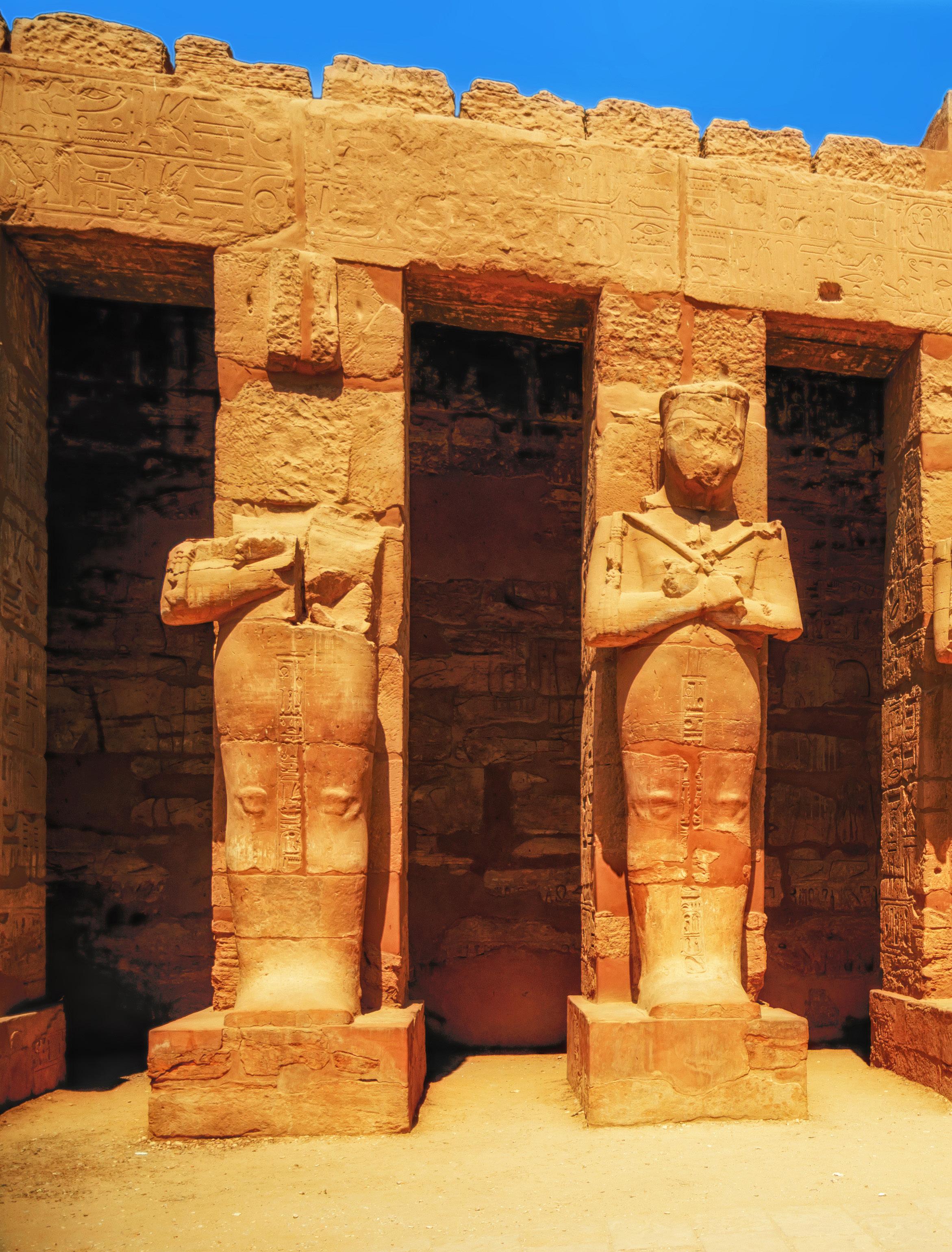
Overview
About 30,000 years ago, the Sahara Desert of north Africa was a grassy plain. It began to dry out around 8000 BCE. This change in climate forced people in the region to move on. Many drifted towards the area next to the Nile River, where the land was more fertile and there was a good water supply.
From this simple start developed one of the world’s first societies –ancient Egypt. It lasted for nearly 3,000 years. As the population grew, the society became more structured. Powerful rulers, called pharaohs, expanded Egypt’s territory. Huge monuments, temples and pyramids were built that would last for thousands of years.



10A How did the physical features of ancient Egypt influence its development?
Lesson 10.1 Ancient Egypt: a timeline
Lesson 10.2 Physical features of ancient Egypt
Lesson 10.3 The climate of ancient Egypt
10A Skills & concepts in context Irrigation in ancient Egypt
10B What shaped the roles of key groups in ancient Egypt?
Lesson 10.4 Key groups in Egyptian society
Lesson 10.5 Pharaohs
Lesson 10.6 Significant individual: Tutankhamun
10B Skills & concepts in context Farming in ancient Egypt
10C How did beliefs, values and practices influence ancient Egyptian lifestyles?
Lesson 10.7 Religious beliefs and practices
Lesson 10.8 Everyday life
Lesson 10.9 Warfare
Lesson 10.10 Death and funeral customs
Lesson 10.11 How mummies were made
10C Skills & concepts in context The Great Pyramid at Giza
10D How did contacts and conflicts with other people change ancient Egypt?
Lesson 10.12 Change through trade
Lesson 10.13 Change through conflict
10D Skills & concepts in context The Battle of Kadesh
Lesson 10.14 Review: Ancient Egypt
Learning intentions and success criteria
c. 8000 BCE
People start forming settlements in the Nile valley.

c. 3200
Earliest known evidence of hieroglyphic writing
Predynastic period 8000−2700 bce
c. 3100
Upper and Lower Egypt unite under Menes.
Source 1 A timeline of some key events and developments in the history of ancient Egypt.
Key content video: Ancient Egypt – a timeline
Sequence this! Events in ancient Egypt
c. 3000
The first buildings are made of mud brick in walled towns and villages.
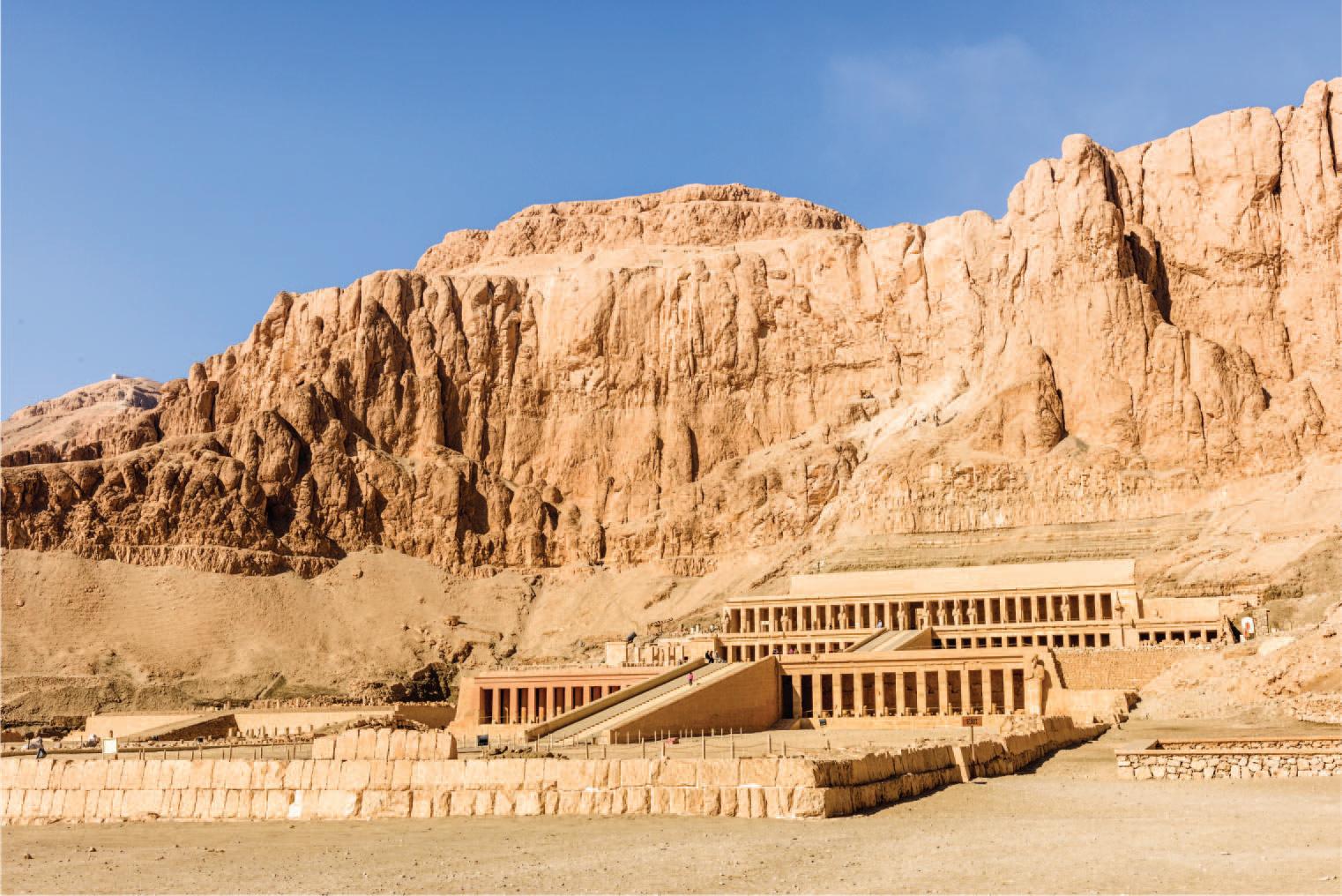
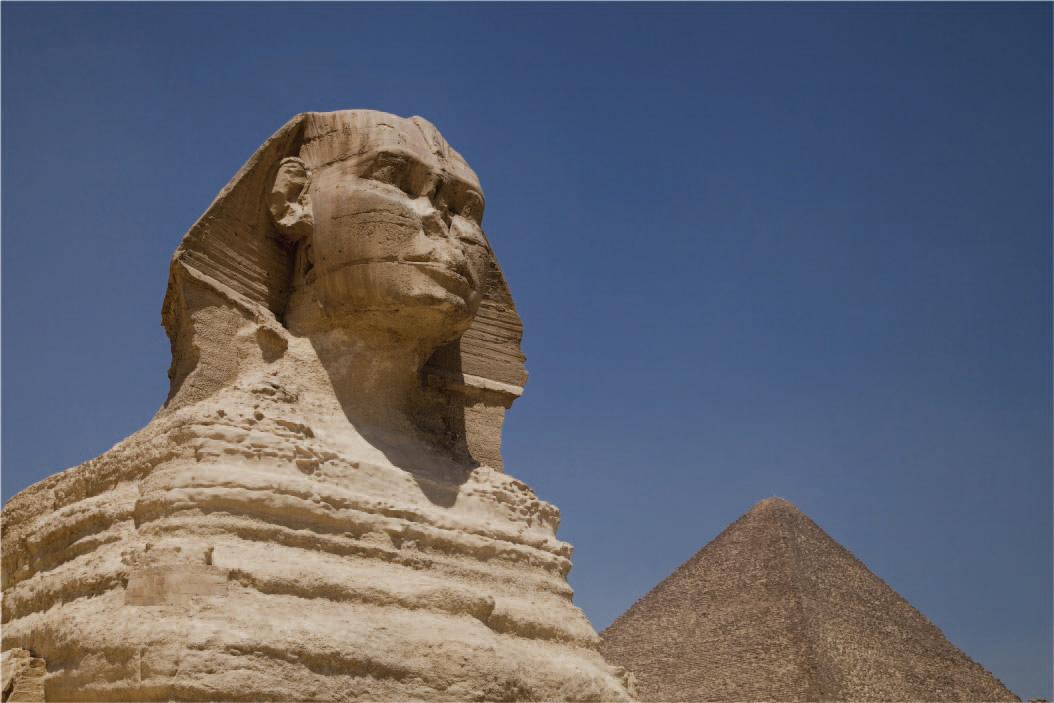
c. 2500
Building of Great Sphinx and Great Pyramid at Giza; Egyptians start experimenting with mummification.
Old Kingdom 2686−2180 bce
c. 2100
c. 2650
First stone pyramid is built in Saqqara for the pharaoh Djoser.
Middle Kingdom 2055−1730 bce
Book of the Dead starts being used in funeral ceremonies.
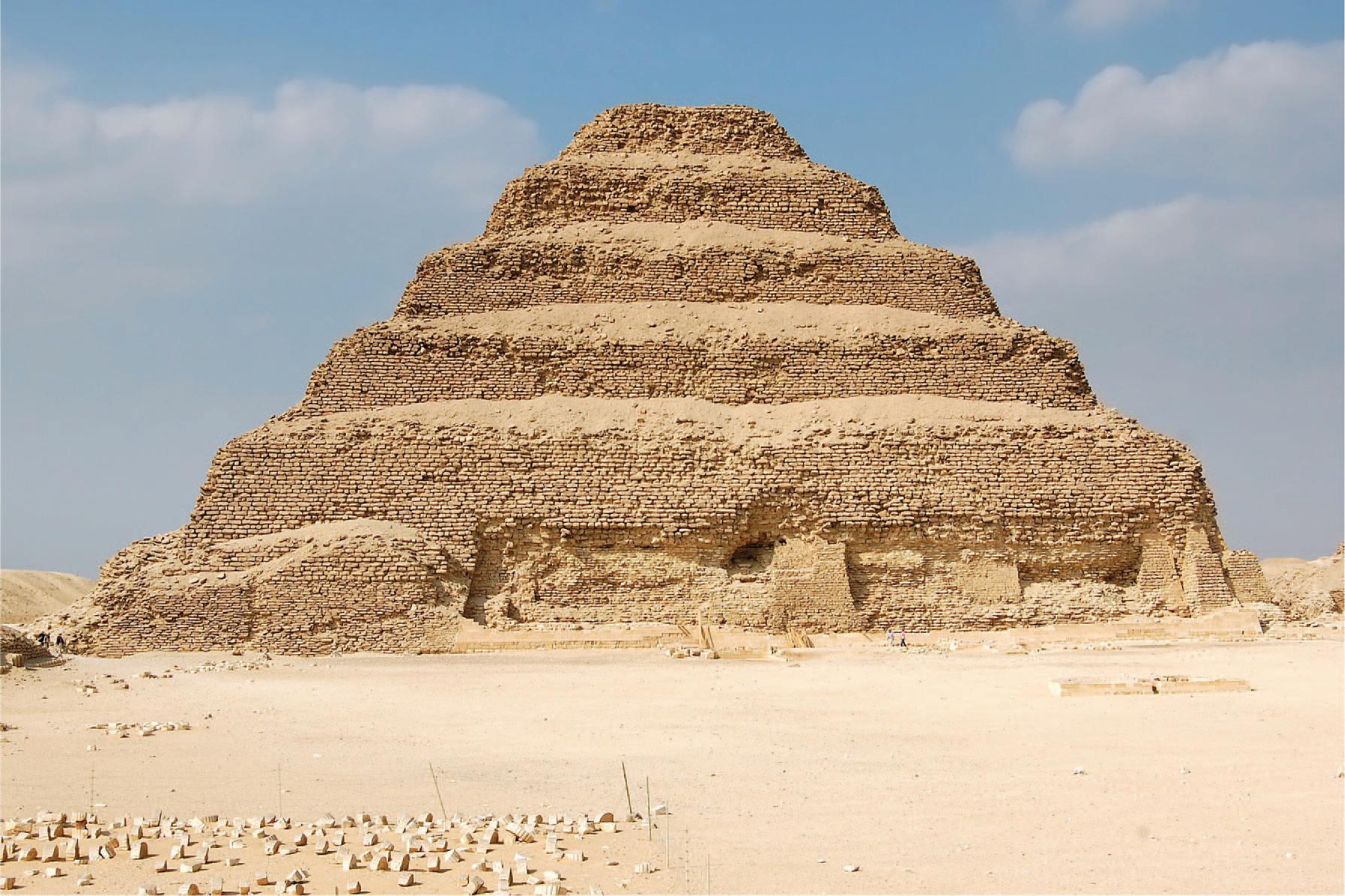



1479
Hatshepsut becomes first female pharaoh.
c. 1550
New Kingdom 1550−1069 bce
Construction of royal tombs in Valley of the Kings
Check your learning 10.1
1274
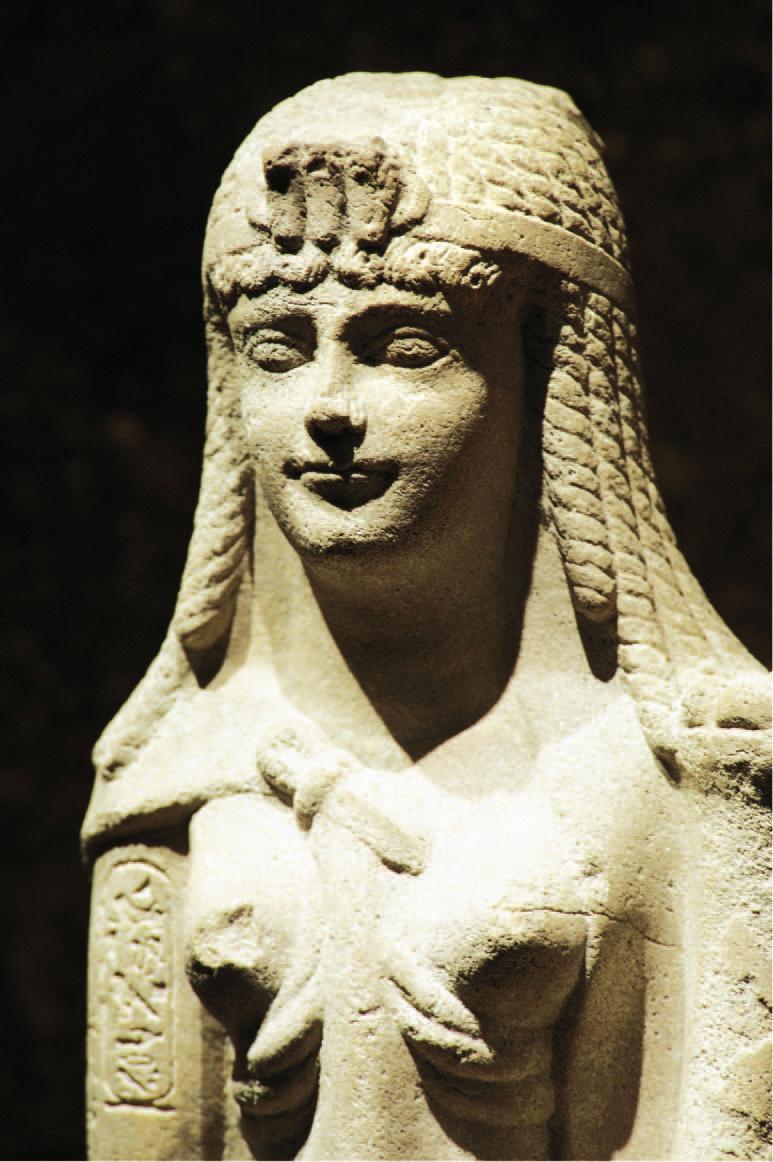
Pharaoh Rameses II claims victory against his enemies, the Hittites, at the Battle of Kadesh.
1332
Tutankhamun ascends throne at age nine, dying ten years later.
51
Cleopatra becomes pharaoh.
30 Cleopatra suicides, and Egypt becomes part of the Roman empire.
Check your learning 10.1
Review and understand
1 Identify the years in which the following events happened:
a people first began to settle in the Nile Valley
b the Great Sphinx and the Great Pyramid at Giza were built
c Hatshepsut becomes pharaoh.
2 Who was Cleopatra? What was the length of her rule?
Apply and analyse
3 Using the timeline, analyse when the period of the most change in ancient Egypt occurred. Remember, when you analyse something you must break it down into smaller parts and explain how they relate to each other.
Evaluate and create
4 The timeline shows that ancient Egyptian society began in approximately 8000 BCE and ended about 332 BCE. During this period, many historians identify four distinct eras, commonly known as the Predynastic period, the Old Kingdom, the Middle Kingdom and the New Kingdom. Research these periods and complete a chart with the following headings.
Period Date Key people Interesting facts
Remember to include references to show where you found your information.
Learning intentions and success criteria
Ancient Egypt was a long, narrow country in north-eastern Africa. The world’s longest river, the Nile, ran the length of the country. Ancient Egyptian lands were also surrounded by a huge desert These features played very important roles in the development of ancient Egyptian society.
The Nile begins in central Africa and flows north into the Mediterranean Sea. The desert made the Nile very important. The river's delta provided the food and other resources needed by the Egyptian people. The Nile was so crucial for the society’s survival that the people worshipped it as a god. They called this god "Hapi".
Key content video:
Physical features of ancient Egypt
Explore it! A virtual field trip to the Nile
The Nile has three main sources – the White Nile, the Blue Nile and the Atbara River. The Blue Nile and the Atbara River begin in the highlands of central Africa. Every summer, they are flooded by melting snow and heavy rains. These waters gush into the Nile, carrying a load of dark mountain silt – soil that is rich in nutrients. Every year, this increase in water caused the Nile to gradually rise and flood parts of Egypt.
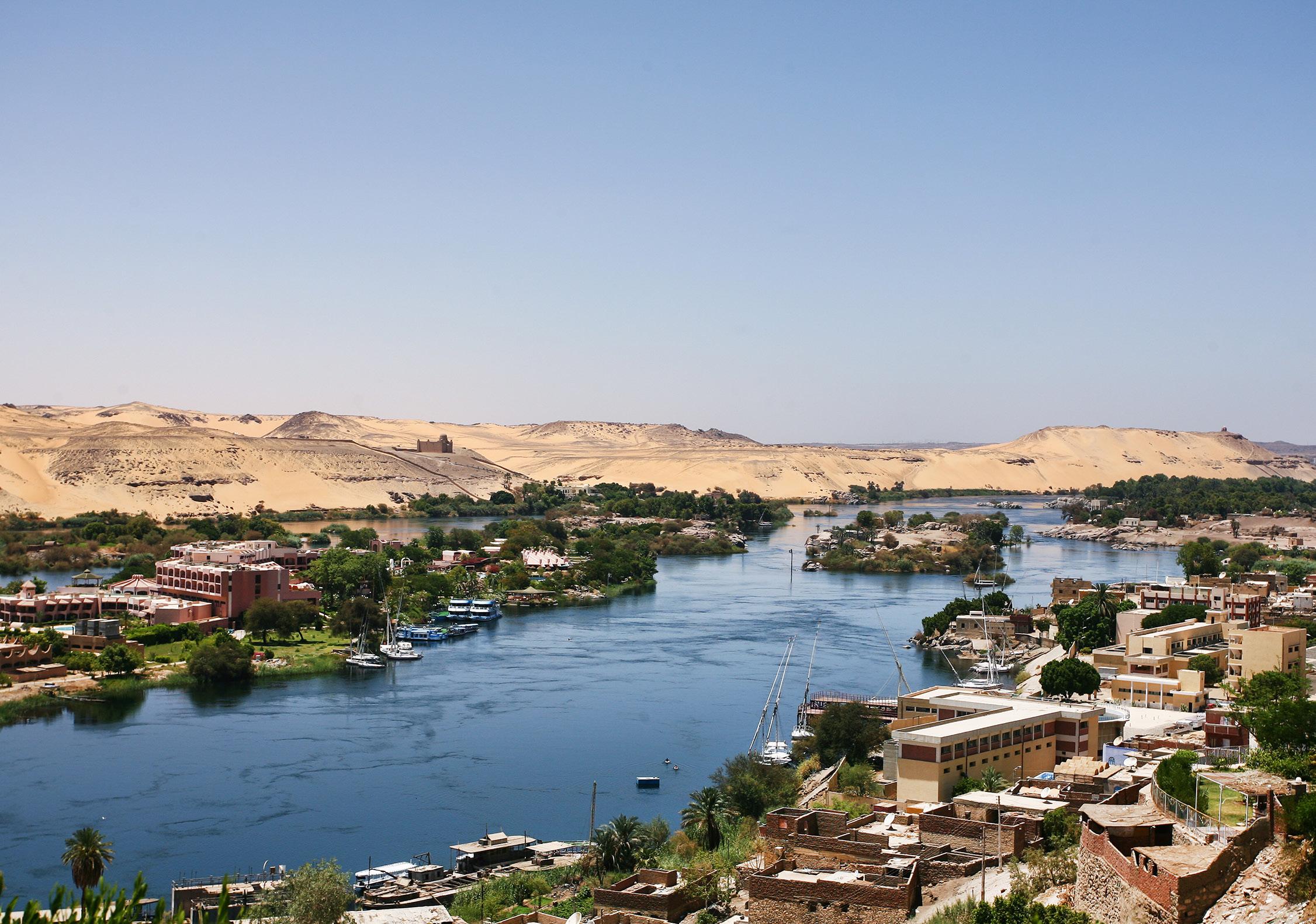
desert an area that receives less than 250 mm of rain every year; can be hot or cold
delta inundation a term used for a flood; there was a yearly inundation (flooding) of the Nile River in Egypt
papyrus a type of riverside plant; the ancient Egyptians made paper from the crushed pulp of the plant
Today, dams have been built along the Nile to prevent it from flooding, but in the days of ancient Egypt, these dams did not exist. Every year in June, the Nile would flood and leave a pile of dark, fertile soil all over the nearby land. This flooding season was known as the inundation. As soon as the floodwaters went back down, the farmers would plant crops such as barley and other grains. These crops would grow very quickly in this fertile soil.
The ancient Egyptians called the fertile land with rich dark soil around the river the "Black Land". This was where most people lived. On each side of the Nile, beyond the Black Land, were large areas of desert. The ancient Egyptians named these areas where few people lived the "Red Land".
The Nile was important for other reasons too. It provided fresh water for drinking and bathing. The ancient Egyptians used spears and nets to catch fish in the Nile. They also caught the birds, such as ducks and geese, that lived near it and used them for food. They picked wild reeds, called papyrus, which grew alongside the river. The ancient Egyptians used these reeds to make a type of paper and boats. The Nile also allowed the ancient Egyptians to travel quickly from place to place, so that they could trade with each other.


Source 1 The boats and houses are modern, but this Nile scene is otherwise as it would have been in the times of ancient Egypt.

Ancient Egypt and the Nile
Interactive: The importance of the Nile
The Nile was the lifeblood of ancient Egyptian society. It provided water for drinking and bathing; fertile soil for growing crops; fish and water birds for eating; and a means of transporting goods. The Nile also played a central role in the s`piritual and religious beliefs of the Egyptians.
An artist’s impression of the central role that the Nile played in ancient Egyptian life.
a Crops included wheat, barley, lentils, beans, grapes, figs and dates. Trained baboons were sometimes used to pick fruit growing too high for people to reach.
b Flax plants were turned into cloth called linen to make clothing.
c Farmers provided labour (during the inundation) to build structures such as the pyramids.
d When the Nile flooded (known as the inundation) the river level rose around 8 metres. The silt it left behind on the floodplains fertilised the soil.
e Villages were built on raised mounds above the usual flood line.
f A network of canals (and later reservoirs) directed and stored river water for use in irrigation.
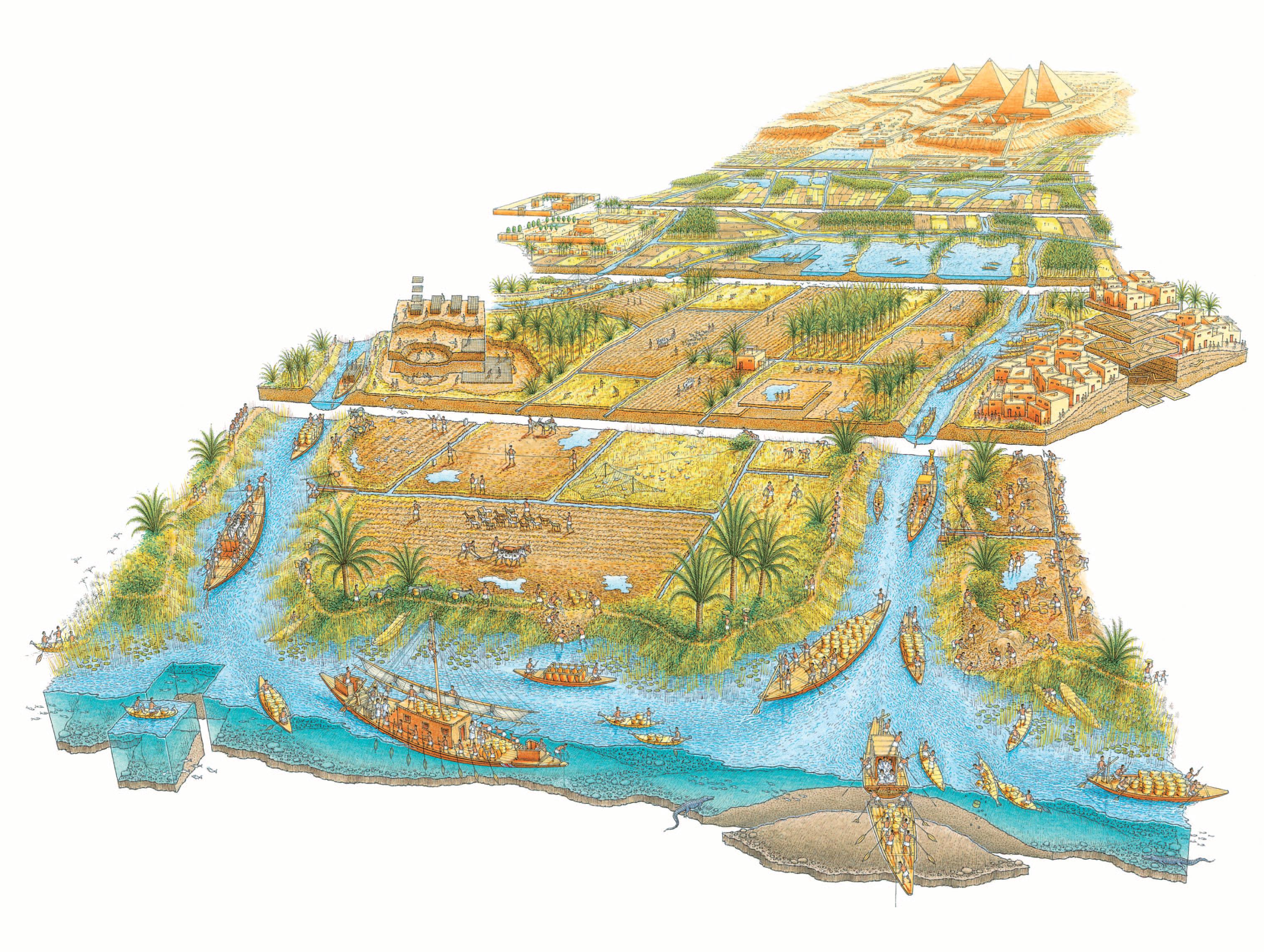
Source 4 An

g A shaduf was used to raise water from the river and direct it into irrigation canals.
h Merchant boats and barges moved trade goods to and from markets. Barges also transported the massive stone blocks used to construct the pyramids.
i The river provided fresh water for drinking, beer making, cooking, washing and irrigation.
j Small fishing boats were made from bundles of strapped papyrus reeds.
k Severe floods could wash away all traces of farm boundary lines (usually marked with stones). Officials known as “rope stretchers” re-measured and re-marked any lines that had disappeared.
l River wildlife included fish, birds, frogs, crocodiles, eels, hippopotamuses and snakes. Ducks and geese were hunted with wooden sticks or caught in nets.
m The riverside papyrus plant was used to make a type of paper (also called papyrus), as well as boats, baskets and furniture.
n Pleasure boats moved travellers up and down the river. Some boats were adapted as funeral boats to carry the bodies of pharaohs to their tombs.
o Bricks were made from riverbank mud. It was sometimes mixed with straw for strength. The mud bricks were packed into moulds and left to dry hard in the sun
The ancient Egyptian ‘seasons’.
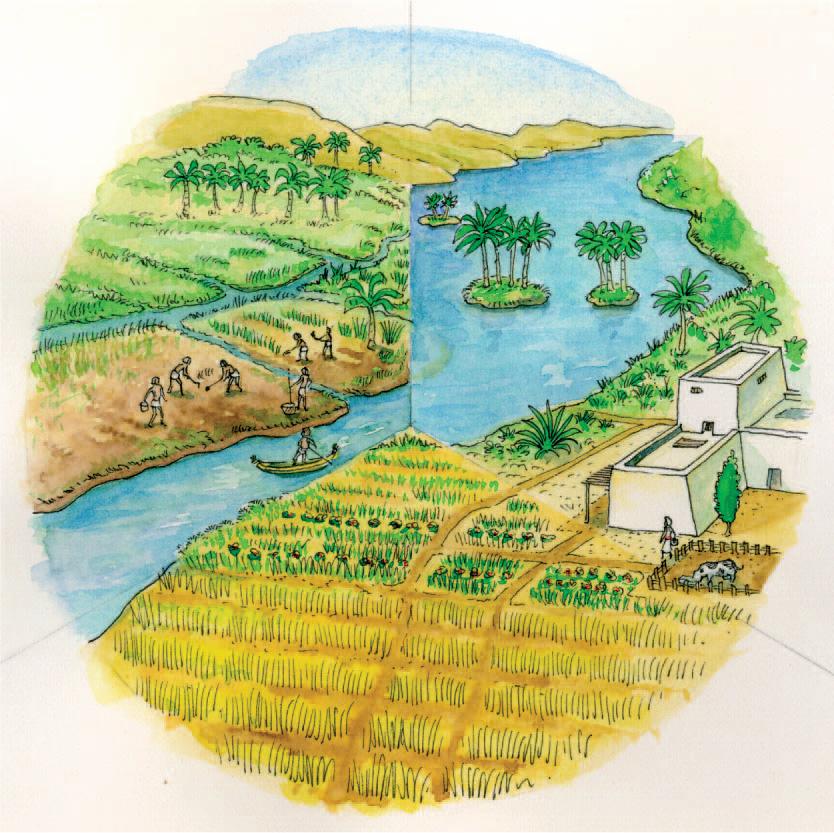
November to February
1 Identify three ways in which the Nile was important to the ancient Egyptians.
2 Identify the month that the Nile flooded each year.
3 Outline the main reasons that:
a the Nile used to flood
b the Nile no longer floods.
4 Describe why the ancient Egyptians called the land along the banks of the Nile the “Black Land”.
Apply and analyse
5 Examine (look closely at) the illustration and labels in Source 4.
a Identify the devices the ancient Egyptians used or made to help store and distribute water to fields.
b What were the different purposes of boats used at the time?
6 Explain how the Nile influenced the ways in which buildings were made and villages designed.
7 Apply the information provided in Source 5 to determine (decide) which “season” it would be currently in ancient Egypt. Explain what would be happening in this season.
Evaluate and create
8 Using the internet, research how a shaduf worked. Propose (put forward) one modification or addition that would make it work better.
9 Imagine you are providing the voiceover for a feature documentary on the Nile. Write a segment explaining the importance of the Nile, why it flooded every year, and how this benefited the people of ancient Egypt. Make your report interesting – remember it is a speaking role!
Ancient Egypt was located within what is now the biggest desert in the world – the Sahara. This meant that the climate of Egypt was incredibly hot and dry.
Being surrounded by desert provided Egypt with some security. Any army that wanted to attack would have had a long, hot walk if invading from the east or west.
The desert was inhabited by many different animals that were hunted by the ancient Egyptians for food. These animals included gazelles, hares and foxes. The desert was also the source of minerals, rocks and metals, which the Egyptians used for building houses, pyramids, statues and tombs, and for making weapons and jewellery. The ancient Egyptians were able to trade many of these resources, as well as the products they made from them.
Source 1 Climate graph for the city of Cairo
Living in a very hot and dry climate, the ancient Egyptians mostly lived an outdoor lifestyle. Most of them worked outside as farmers, fishers, builders and merchants. People cooked and often slept outside their homes (frequently on the roof) because of the heat.
Source 3 A headrest used by the wealthy while sleeping. It allowed air to circulate around the head and neck.
Rich or poor, most Egyptians lived in houses that were similar in design. They had flat roofs and were made from sundried mud bricks. Most houses were single-storey structures.
The one-room homes of poor farmers had dirt floors. In urban areas, houses were joined, rather like apartments and terrace houses are today.
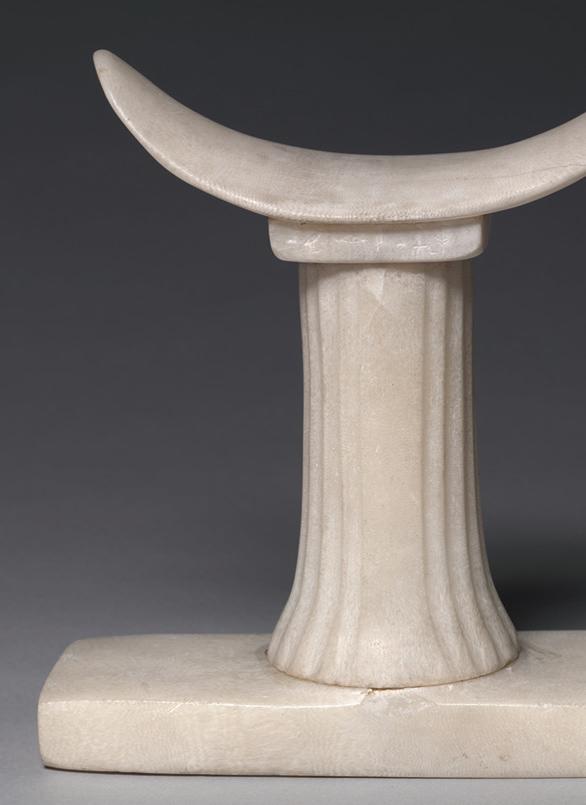
The people of ancient Egypt dressed very lightly because of the heat. Men (including the pharaoh) often went bare-chested and wore short linen tunics. Women usually wore long linen dresses. Most clothing was white, which is cooler than darker colours because it reflects the heat. Leather or papyrus sandals were sometimes worn by the rich, but most people went barefoot. Children and slaves were usually completely naked.
Because of the desert surrounding ancient Egypt, dust, glare and wind-blown sand were a fact of life. Eye infections were common. Stone carvings have been found in tombs that show groups of blind people. Ancient papyrus texts show that bat blood was one treatment for eye problems. Another treatment was to rub a paste of mashed human brain and honey over the affected eye. Both men and women wore heavy eye make-up, called kohl, to help protect their eyes from dust and glare. Men and women would also wear wigs, usually over a shaved scalp. Shaving kept heads
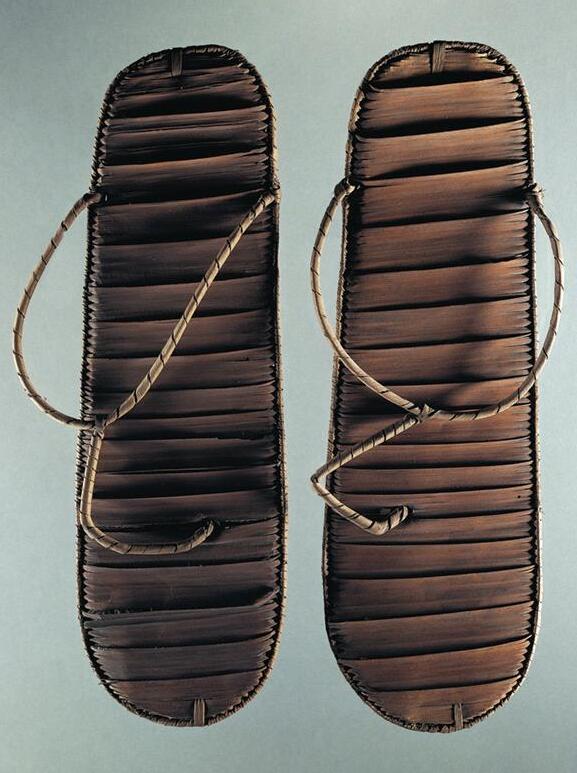
pharaoh the leader of ancient Egypt who was believed to be a god; the pharaoh had absolute power and total control linen a natural fabric, made from the flax plant, that allows sweat to evaporate more easily
cool (when at home, without wigs) and allowed scalps to be kept clean. Sometimes, a cone of solid perfumed fat was worn on top of a wig on special occasions (see Source 5). As it slowly melted in the heat, sweet-smelling liquid dripped over the face and upper body, cooling the skin.
For more information on using historical sources, see Lesson 6.4 Using historical sources [crossreference:Lesson 6.4 Using historical sources]
Source 5 This detail from an Egyptian tomb shows a woman wearing heavy eye make-up and a cone of scented fat on top of her wig.

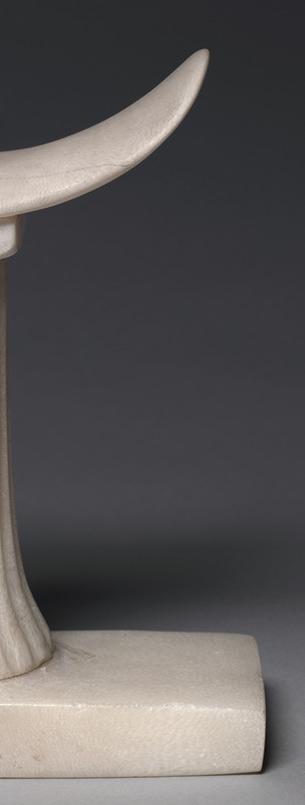
1 Identify three resources that the desert provided for the people of ancient Egypt.
2 Identify where the people of ancient Egypt often cooked and slept. Apply and analyse
3 In your own words, summarise the advantages and disadvantages of shaving your head and wearing a wig when living in a location like ancient Egypt.
4 Examine (look closely at) Source 1.
a During which months, on average, was there no rain in Cairo? Identify the average temperature for each of these months.
b Melbourne’s highest rainfall occurs from September to December, with monthly rainfall averaging between 58 and 66 millimetres in those months. Outline some of the differences between average rainfall in Cairo and average rainfall in Melbourne.
Evaluate and create
5 Evaluate the positives and negatives of Egypt’s climate. Remember, when you evaluate something you should talk about its strengths and weaknesses. Be sure to give your overall opinion.
6 Create a diary entry in which you describe the climate and desert of ancient Egypt, as if you had lived there.
The annual inundation (flooding) of the Nile was so important to the ancient Egyptians that they organised their lives around it.
Flooding happened in a season the Egyptians called akhet . As the flood receded, the fertile silt left on the ground near the river ensured perfect conditions for proyet , the growing season, which was when farmers would plant and grow their crops. The crops would continue to grow until they were picked in shomu, harvest season. During proyet the ancient Egyptians needed to irrigate (water) the crops they had planted. They experimented with many different kinds of irrigation over the course of their history.
Key concepts & skills Using historical sources
Key concepts & skills answers: Irrigation in ancient Egypt
Interpreting primary sources
Primary sources are things that were created during the time being studied. They can be documents, objects, paintings and other sources that provide us with a firsthand account of what life was like in the past.
primary source a source that existed or was made in the time being studied
Because they are firsthand accounts, primary sources often convey the creator’s point of view, attitudes and values. It is important that you can identify and describe these elements in their work. Use the following steps:
• Step 1 Ask yourself what factual information is conveyed in this source. (Be careful: sometimes things that are presented as fact are not always accurate, so you might need to think about whether the information can be verified. Where else might you look to check and make sure those “facts” are accurate?)

know about what the creator of the source and the people around them believed? How would you feel if you were in the creator’s shoes?
• Step 3 Ask yourself what opinions are expressed in the source. If the source is written, which specific words or phrases show how the writer feels?
• Step 4 Ask yourself what is implied in the source. For instance, people do not always spell out what they are thinking when they write something. The reader needs to use clues in the text to “read between the lines” and infer meanings that are not spelled out.
• Step 2 Think about how the world described or depicted in the source is different from the world you live in today. What do you already
The following primary sources provide evidence about the beliefs, values and attitudes of the ancient Egyptians towards the Nile and the annual inundation, as well as important types of irrigation technology that were developed. For more information on using historical sources, see Lesson 6.4 Using historical sources [cross-reference:Lesson 6.4 Using historical sources]

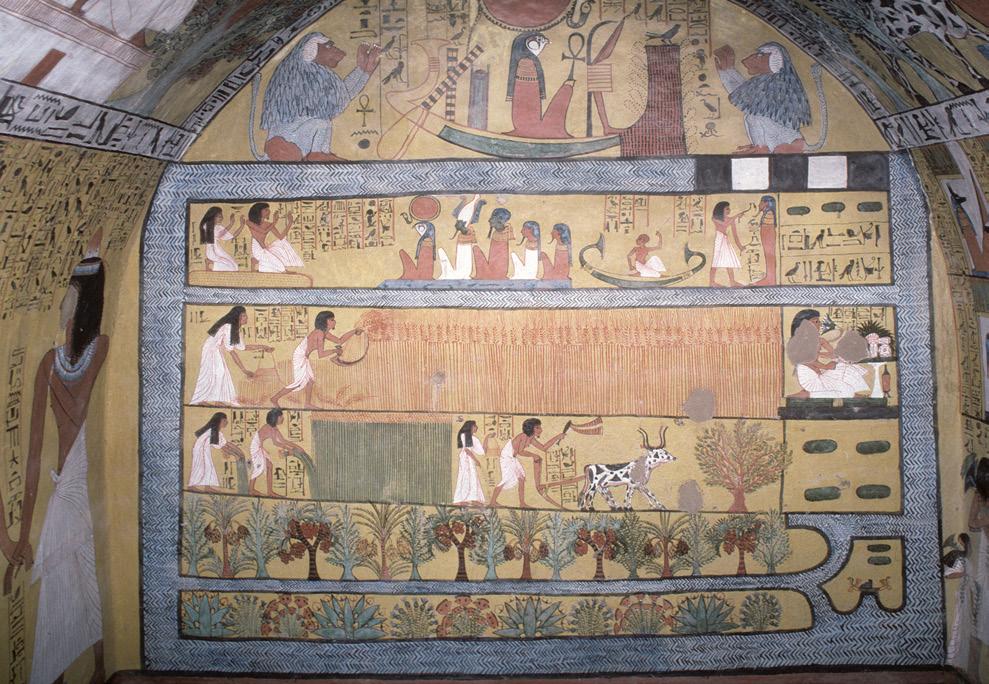
Canals


Source 5
Hail to you, Nile River! You show yourself over this land, and come to give life to Egypt! Your source is mysterious, but we celebrate the day when you come to us! Watering the orchards created by Ra, to cause all the cattle to live, you give the earth to drink, inexhaustible one!
Lord of the fish: during the inundation, no bird lands on the crops. You create the grain, you bring forth the barley, you make sure the temples will last for eternity. If you stop your toil and your work, then all that exists in our world will be in trouble.
Worksheet: Irrigation technology in ancient Egypt (Worksheet answers)
Practise the skill
1 Read Source 5 carefully.
a Identify the factual information in this source.
b Explain the writer’s beliefs and attitudes about the annual cause of the inundation. Remember to identify the specific words or phrases in the source that support your conclusion.
c What can you tell about the writer’s values?
2 Use Source 2, Source 3 and Source 4 and information gathered on the internet, to compare the use of canals, shadufs and waterwheels in ancient Egypt.
Extract from ‘Hymn to the Nile’, written c . 2100 BCE in ancient Egypt.
1 Using the results of your research, write a short report on the history of irrigation technology in ancient Egypt. Make sure you:
a include an introduction explaining why irrigation was so important in ancient Egypt
b include a main body, broken up into sections (with subheadings) that describe each type of technology (for example, "canals", "shadufs" and "waterwheels")
c explain within each section when this type of irrigation technology was invented and how it worked. Include diagrams if you wish.
Learning intentions and success criteria
hierarchy a way of organising things (or people) from top down in order of importance or significance; ancient societies had strict hierarchies with a ruler at the top and peasants at the bottom
The society of ancient Egypt was well organised. Ancient Egyptians had a central government and, from the fifteenth century BCE, they also had a professional army. People knew what their social responsibilities were. Some of these roles were shaped by the society’s laws and traditions. Some were determined by religious beliefs. Other roles were determined by a person’s wealth and abilities (such as whether they could read and write).
The society of ancient Egypt was a hierarchy. At the top was the royal family: the pharaoh and his family. At the bottom were the slaves and the poorest of the poor farmers.
Men usually did the jobs their fathers did. They learnt the skills a bit like apprentices learn trades today. Education was the key to improving a person’s position in society. A merchant, or even a farmer, could do this by learning to read and write.
Source 1 The social hierarchy (structure) of ancient Egypt (from top to bottom).
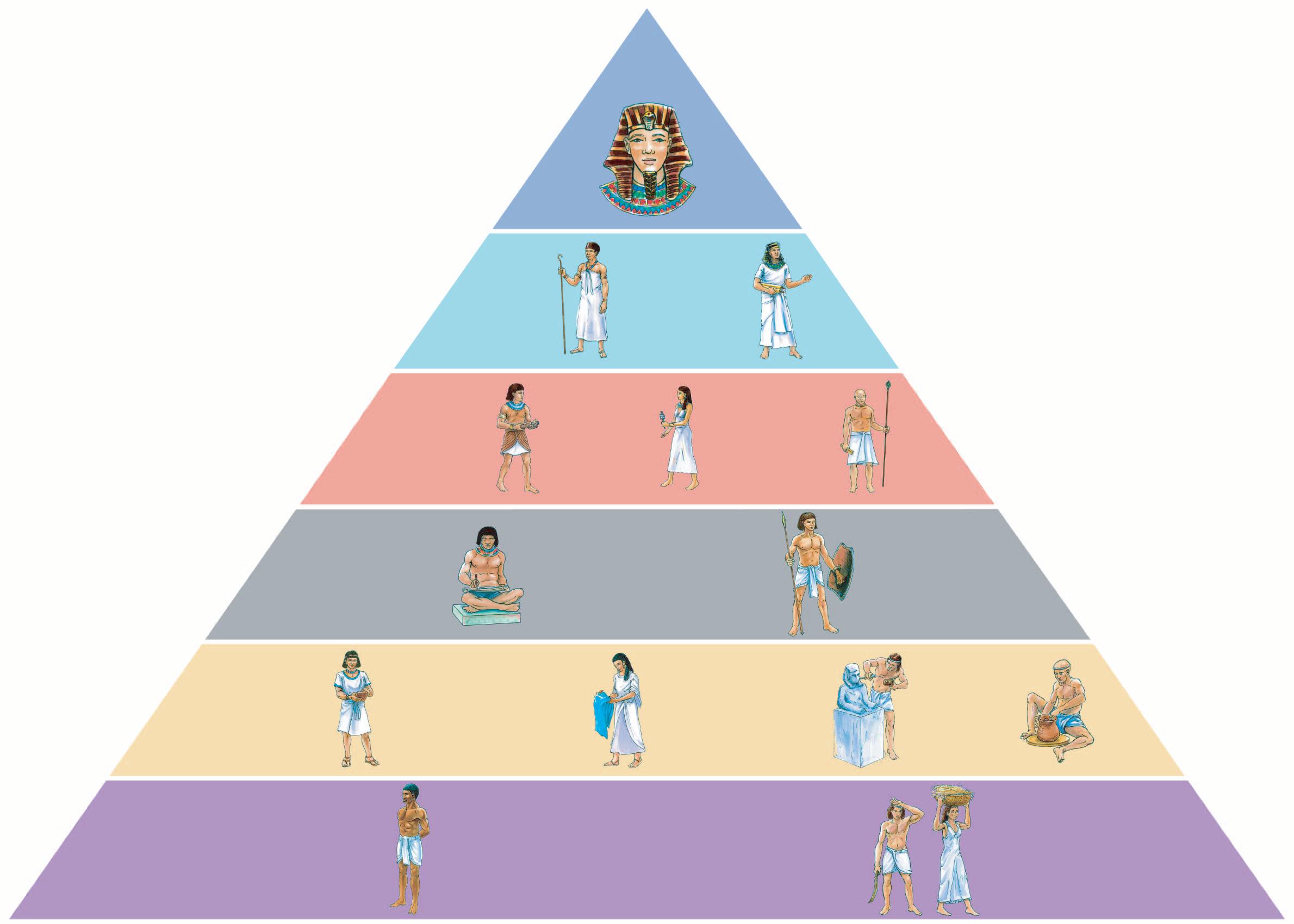

1. Pharoh: His main duty is to keep life in balance – on this Earth and beyond and govern with a large team of officials.
2a. Vizier: The pharaoh's second-in-command supervises the other officials and judge law-breakers and make sure people pay their taxes, in grain or goods and sometimes labour.
2b. Director of the Seal: The treasurer who manages all the goods (food and other products) that come into the pharaoh's storehouses. Most of these goods are tax payments, but some items are imports from other countries.
3a. Nomarch: Governs one of the country's 42 nomes (provinces). He keeps the Vizier happy by collecting lots of taxes. Like other important and wealthy people, he wears garments made from the finest linen and lots of gold jewellery.
3b. Priestess: Her main role is to help look after the temple goddess and to sing and play music if the pharaoh visits the temple. She reports to the chief priest. Her husband is a nomarch. Most priestesses are married to senior officials –the high priestess in her temple is a daughter of the pharaoh.
3c. Chief priest: Represents the country's top priest, the pharaoh, and looks after the gods. He enters the inner part of the temple where the statue of the god is kept. Each day, he washes it, wraps it in clean linen and brings it food. If he didn’t do this, bad things would happen. On special days, he takes it out to show the people. He and his priests don't wear clothing made from animal products because that would be unclean. They wear only the finest white linen. They shave all their body hair and wash many times each day.
4a. Scribe: One of the very few people in Egypt who can read and write. He records the pharaoh's orders and decisions, and helps the Vizier and the Director of the Seal to keep tax records. He also keeps accounts for the army, writes letters for local people and prepares inscriptions for tomb walls and sculptures.
4b. Soldier: Very skilled at using a pike (spear), they march on foot but their army also has charioteers. Army divisions – all
named after gods – usually consist of about 5000 men. They often fight alongside mercenaries – men from other countries who are paid to fight for them. Many come from Nubia. When not at war, they help out by supervising building projects.
5a. Merchant: A trader who sails up and down the Nile with goods from Egypt, such as linen, papyrus, pottery, grain and gold. He brings back goods from other places like ebony wood, ivory, incense, copper and baboons. Sometimes, he sails north, across the Mediterranean Sea.
5b. Linen workshop supervisor: Typically, they are homemakers raising their children. They make linen from flax where it could be traded for other things at the local market. Some are supervisors managing women in a linen workshop.
5c. Stonemason: Spends his days making stone statues (usually of the pharaoh), carving the blocks used to build temples and pyramids, and engraving the walls of tombs.
5d. Potter: Members of the middle class - not too poor, but not too rich either! They give some of the pots they make to the pharaoh as a tax payment, while others are exported to other countries. Most learnt our trades from their fathers. Some make jewellery; others make papyrus, boats or furniture.
6a. Farmer and his wife: Except for slaves, they are at the bottom of the social ladder (along with tomb builders, pig herders and beggars). They grow wheat and barley, and flax used to make linen. Farmers work very hard, digging canals for irrigation and preparing the soil. Their wives help them in the field when they can. During the inundation, farmers help out with the pharaoh's building work. They pay over half of the grain they produce as tax.
6b. Slave: Typically, they were born in Libya but captured as a prisoner of war. Other slaves come from Syria and Nubia. Their masters use them as field hands. Some of the lucky slaves work in the palace of the pharaoh – much better than working in the quarries or mines out in the hot desert.

Source 2 Inside the tomb of Rameses VI. In keeping with the pharaoh’s position at the top of the social hierarchy, their tombs were grand and highly decorated.
ClickView video: Women of the Ancient World (Egypt) – Pharaohs and physicians
The role of most women in ancient Egypt was to raise a family. Pregnancy was always a celebrated event. It was common for a woman to have lots of pregnancies, and many women died in childbirth. Girls were often married as young as 12, and were expected to have children quickly. Life expectancy was low. A poor woman might only live until she was 30.
Poorer women usually devoted their entire lives to raising their children, keeping house and helping their husbands with planting and harvesting crops.
Upper-class women, such as the wives of pharaohs and nobles, had more pampered lives. They had servants to wait on them, and fine clothing and jewellery to wear (see Source 3). If they were the eldest child, they inherited their father’s wealth.
The man was the head of the household in ancient Egypt, but women had more freedom than in many other ancient societies, such as ancient Greece. This may partly be because of Egyptian religious beliefs. The ancient Egyptians saw their world as being controlled equally by male and female deities

Women could own land and businesses, keep the children if there was a divorce, and openly breastfeed their children. They could make wills, testify in court and bring legal actions against men. Women could also hold jobs. For poorer women, a job meant manual labour. These women would work on farms, look after animals or even become weavers. Some might have worked as singers or dancers. Wealthier women might work as priestesses.
Many people think that slaves were used to build the pyramids. Actually, there is little evidence to support this. Records suggest that there were not many slaves during the Old Kingdom, when the pyramids were built. Rather, it is thought they were built by peasants and farmers who could not work on the land during the rainy season.
The number of slaves in ancient Egypt did increase during the Middle and New Kingdoms. Most were prisoners of war. Others were bought and sold at markets, or were unlucky travellers captured by slave traders.
The role of the slave was often to be a faithful servant in the households of pharaohs, nobles and priests. They could own land and hire servants. They could marry those who were not slaves. Some talented or beautiful slaves were able to get promoted to senior or privileged positions. Less fortunate slaves were sent to work in the gold and copper mines of north Africa’s deserts. They often died of thirst or heat exhaustion.
Considering perspectives
As with today, a person’s experience and perspective of the world was influenced by their standing in society. For example, in ancient Egypt, the pharaoh was likely to have experienced life in a way that was very different to that of a farmer. It is therefore important to ask questions about where a primary source comes from, why it was created, and what it tells us about the world it portrays.
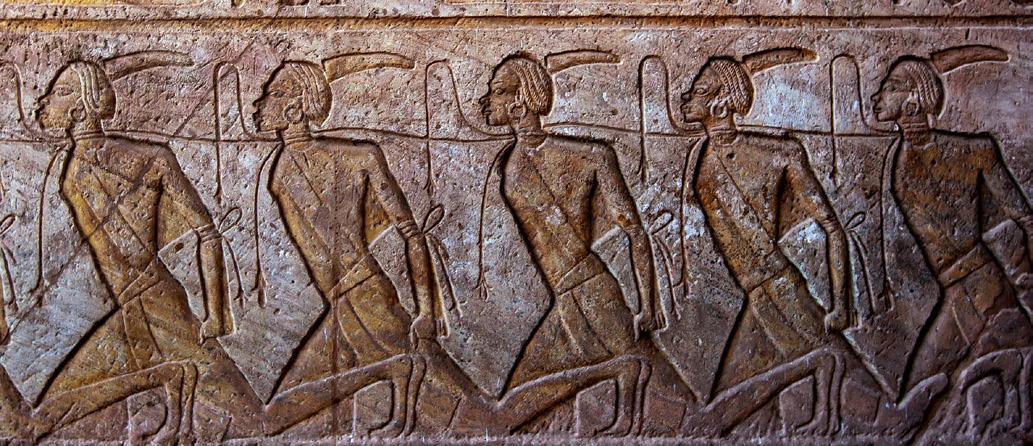
Look closely at Source 3. This painting depicts Egyptian women celebrating at a feast. These women are being attended by servants, which suggests that they were rich women with a high standing in society. Think about how the perspectives of the women in this painting would be different to that of the slaves. Do you think they would have the same perspective, or would it be different?
Complete the key skill worksheet on Oxford Digital.
and understand
1 List these social roles in order (from most to least important) according to the values of ancient Egyptian society: potter, merchant, pharaoh, farmer, priestess, vizier, scribe.
2 Outline how a farmer’s social role and standing might change if he learnt to read and write.
3 Identify the types of duties most slaves were expected to carry out. What types of duties were less fortunate slaves expected to carry out?
Apply and analyse
4 Compare the roles of a chief priest and the vizier in ancient Egypt. Remember, when you compare two things you must talk about how they are similar and how they are different.
5 In your own words, summarise how religious beliefs in ancient Egypt shaped the role of women.
6 Compare the perspectives of rich women and poor women in ancient Egypt. How might these two groups of women have perceived life in ancient Egypt? Do you think it would be similar or different?
Evaluate and create
7 The powerful roles in ancient Egyptian society were those of people who were wealthy, had political power or had religious authority.
As a class, discuss the extent to which this represents the situation in Australia today.
Learning intentions and success criteria
The pharaoh was the head of Egyptian society and was almost always a man. Pharaohs were regarded as god-kings, and were seen as descendants of Ra, the sun god. People knelt and kissed the ground when they met the pharaoh. Pharaohs were very wealthy, owning all the land and its resources. They placed taxes on the people, which were usually paid to them in the form of grain and other crops. In addition to power, pharaohs had a number of responsibilities, some of which were shaped by law, others by religion (see Source 1).
Source 1 Responsibilities of the pharaoh as god-king
Earthly responsibilities (shaped by the law)
The pharaoh was responsible for:
• directing the government
• commanding the army and leading it into battle
• protecting the people and keeping peace and order
• making all laws, and sometimes making decisions in the courts
• managing building, mining, trade and irrigation.
Divine responsibilities (shaped by religion)
The pharaoh was responsible for:
• acting as chief priest
• keeping the gods happy so the Nile flooded every year and harvests were plentiful
• choosing priests
• overseeing religious ceremonies and festivals
• building temples to honour the gods
• performing religious duties.
Source 2 An artist’s impression of a pharaoh and their symbols of power.
a A crown symbolised the pharaoh’s position as chief ruler. The crown shown here was the official crown; its design is a combination of the white crown of Upper Egypt and the red crown of Lower Egypt that merged to form a united Egypt. Pharaohs also wore a range of other headgear depending on their duties.
b The uraeus (gold headpiece shaped like an upright cobra) symbolised magical powers and a readiness to strike.
c A false beard made from goat’s hair symbolised the pharaoh’s status as a god.
d The heavy jewelled collar symbolised great wealth.
e The flail (whip) symbolised total authority.
f The crook symbolised the pharaoh’s role as a shepherd of the people.
g An animal tail (usually from a bull) symbolised strength and fertility.
Key content video: Pharaohs
Analyse this! The power of the pharaohs

By about 3300 BCE, the Nile settlements were grouped into two kingdoms: Upper Egypt and Lower Egypt. These united in about 3100 BCE. For the next 2800 years, the unified kingdom of Egypt was ruled by pharaohs, thus creating the world’s first national government.
The laws and traditions of ancient Egypt meant that a pharaoh passed on his power as ruler to the son (usually the eldest) of his main wife – in the ancient world, it was common for men to have more than one wife. If the main wife did not have a son, the son of a less important wife would become the new ruler, or heir. The period where members of the same family ruled was known as a dynasty. Sometimes, someone from outside the family seized power and became pharaoh. This meant the start of a new dynasty.
In 332 BCE, Egypt was conquered by the king of Macedon (modern-day Macedonia), known as Alexander the Great. He started what was to be the last dynasty in ancient Egypt, known as the Ptolemaic Dynasty. This dynasty lasted until 30 BCE when its last ruler, Cleopatra, committed suicide. After that, Egypt became part of the Roman Empire.
Hatshepsut – 18th-dynasty ruler
Hatshepsut was one of few female pharaohs. She ruled between about 1473 and 1458 BCE. When she became pharaoh, she wore a false beard, men’s clothing and a bull’s tail, and changed her name to its male form. She ordered the construction of many buildings, paid for many trading expeditions, and rebuilt trade routes that had been damaged by former invaders.
Review and understand
1 Outline the main difference between the pharaoh’s divine role and earthly role.
2 In your own words, define the term ‘dynasty’ and give reasons why a dynasty usually changed. Apply and analyse
3 ExamineSource 2. Copy this table and add at least three items to each column.
Item worn or carried by the pharaoh What it symbolised
4 Suggest why the ancient Egyptians knelt and kissed the ground when they met the pharaoh.
5 Consider some of the items the following people
heir a person who has the legal right to receive somebody's property, money or title when that person dies dynasty a period of rule by members of the same family who come to power one after the other

wear or carry to reflect their social position or role. For each item, determine what it symbolises:
a the King
b a high-ranking soldier
c an Australian High Court judge
d the principal of your school.
Evaluate and create
e How did Hatshepsut adjust her appearance to suit her role as pharaoh? Discuss why she would have made these changes.
f Do you think people today feel pressured to change their appearance and behaviour when they move into a public leadership role? Discuss with a partner. Give examples if possible.
Learning intentions and success criteria
Key content video:
Significant individual –Tutankhamun
Quiz me! Tutankhamun
mummy a body of a human or an animal that has been mummified
canopic jar a jar used in ancient Egypt to store body parts removed during the mummification process
mummification the process of preserving a dead body by preventing its natural decay; in ancient Egypt a body was mummified by removing internal organs (except the heart) and drying out the remaining body tissue, and the mummy was then buried
Tutankhamun (c. 1342–1323 BCE) is the world’s best-known pharaoh and one of the most studied figures in history. He was a boy when he became pharaoh in 1332 BCE and only ruled for 10 years, yet his story still captivates people all over the world. Scientific analyses of his remains reveal that he was about 170 centimetres tall, with a slight bend in his spine. He had an overbite, a cleft palate and an elongated skull. He was only 19 when he died. He did not live long enough to do much that was remarkable. He did, however, change the command of his predecessor, Akhenaten, that the people only worship one god – Aten, a Sun god. Tutankhamun declared that Egypt’s old gods could again be worshipped. He restored their temples, priests and festivals. He also reversed Akhenaten’s decision to move ancient Egypt’s capital. He moved the capital to Memphis.
Despite his short life, Tutankhamun is significant because his tomb is the only ancient tomb in Egypt so far found not to have been broken into by robbers. It contained over 5,300 sources of evidence of his life and burial practices at the time. These sources include his decorated gold throne and his nest of coffins.

The English archaeologist Howard Carter found the tomb in 1922. It was at the end of a long tunnel in the Valley of the Kings. This was a deep, rocky valley close to the Nile where many pharaohs were buried. Carter reported: “At first I could see nothing … but as my eyes grew accustomed to the light, details of the room within emerged slowly from the mist, strange animals, statues and gold –everywhere the glint of gold!”
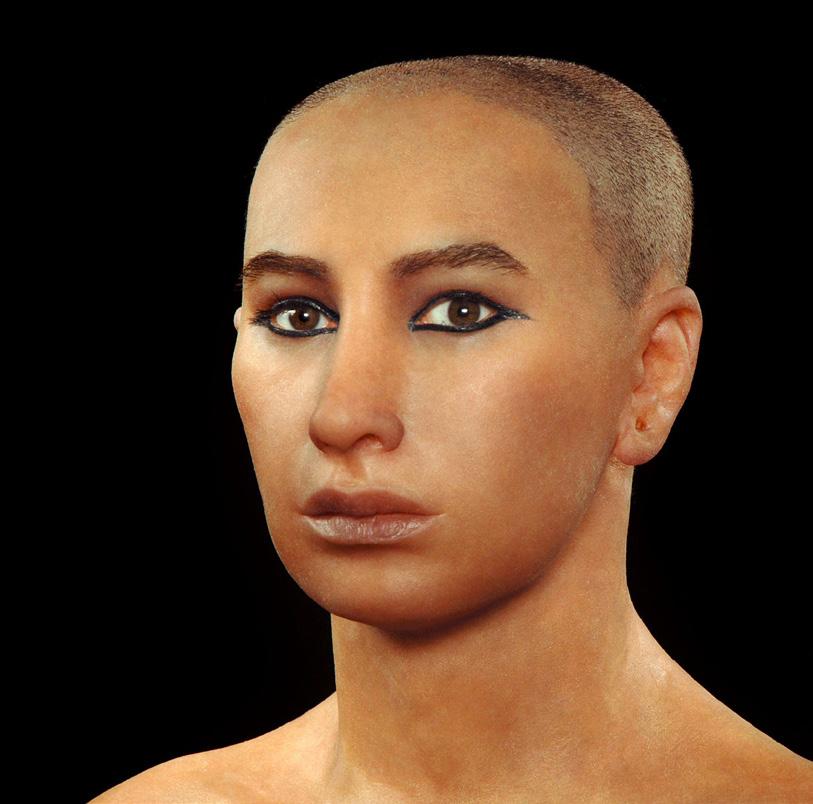
Tutankhamun’s mummy lay within a solid-gold body-shaped coffin (110 kilograms in weight) in the burial chamber. This coffin was enclosed by two more coffins. In the treasure chamber next door were four canopic jars holding the pharaoh’s mummified liver, lungs, stomach and intestines.
His body was covered in amulets and jewels, and he was wearing an 11-kilogram solid-gold burial mask inlaid with precious stones. Carter and his team used hot knives to remove the mask. They also cut up the body to retrieve the jewels and amulets that were wrapped up in his bandages.
Since then, conservators (people responsible for preserving important historical sources) became more worried about the damage that was still being done to Tutankhamun’s mummy. When visitors entered the tomb, their breath and body heat caused damage to the mummy and other parts of the tomb. Tutankhamun’s remains stayed within his coffin until November 2007, when they were moved into a special, climate-controlled case within the tomb.
To this day, historians cannot agree on how Tutankhamun died. Some historians used to think he was murdered, because there was a hole at the back of his skull and a floating piece of bone behind his eyes. This view has been contested in more recent years.
In 2005, an extensive number of CT scans (special X-rays) were taken of Tutankhamun’s remains. These scans led the Egyptian archaeologist Zahi Hawass to conclude that
and understand
1 Who was Tutankhamun?
2 Identify two changes that Tutankhamun made during his reign. Apply and analyse
amulet a charm thought to keep away evil
I used to think, now I think
Reflect on your learning about Tutankhamun and complete the following sentences.
I used to think …
• Now I think … What has changed in your understanding?
he died of a complication from a broken leg –specifically, gangrene (which is the rotting away of living tissue). He thinks the break in the leg became infected. The hole in the skull, he thinks, might have been a mummification accident. Other historians have found evidence to suggest that Tutankhamun might have had malaria, which could have contributed to his death.
For more information on using historical sources, see Lesson 6.4 Using historical sources [cross-reference:Lesson 6.4 Using historical sources]
3 Tutankhamun did not live long enough to do much that was considered remarkable. Explain why historians still regard him as significant.
4 Analyse the treatment of Tutankhamun’s remains by archaeologists. How has the discovery of his remains put them at risk? Has enough been done to help conserve them?
5 Explain why the cause of Tutankhamun’s death has been contested by historians.
Evaluate and create
6 Create a diary entry that Howard Carter might have written after discovering Tutankhamun’s tomb. Use the internet to research more about the discovery and the tomb’s contents.
Source 3 The mummified head of Tutankhamun
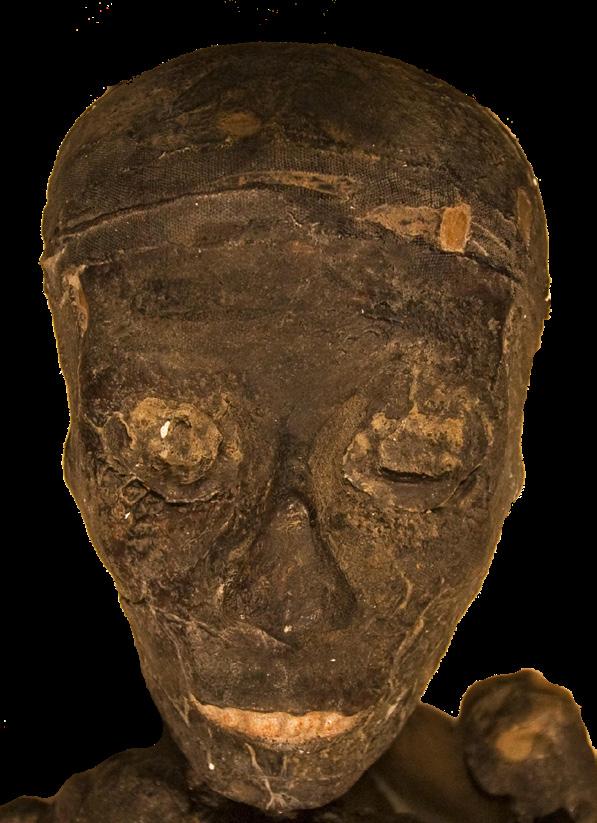
Farmers in ancient Egypt prospered because of the fertile land along the banks of the Nile. Farming was so central to the success of ancient Egypt that many aspects of society were shaped by it, such as the calendar, the design of houses,
Historians focus their research on sources that are relevant. After locating a range of sources that they think might be useful, historians need to analyse them to discover if they contain evidence that will be relevant to the particular question they are investigating. The evidence is the information contained in or gathered from the source. A source becomes evidence if it can be used to answer a particular question about the past.
The first thing you must do before attempting to locate, compare, select and use a range of sources as evidence is to be very clear about the historical questions you are investigating. In this key skill, your research questions are:
• What were farming practices like in ancient Egypt?
• What role did farmers have in the social hierarchy?
even the class system. Most of the pharaoh’s wealth came from the taxes paid in grain by farmers. This grain was stored in plentiful years for use when food was in short supply.
You need to keep these questions in mind as you work through the following steps:
• Step 1 Look at the source carefully and note the obvious things that it is telling you.
• Step 2 Look beyond the obvious and see what you can infer; that is, what can you work out from what you see in the source, even though it may not be immediately obvious?
For a more information on historical significance, see Lesson 6.7 Historical significance [cross-reference:Lesson 6.7 Historical significance].
Source 2, a wall painting from the tomb of an important official called Menna, provides a lot of information about ancient Egyptian farming, including crops, tools and farming methods. It is a very useful primary source.

Source 1 Egyptian agriculture involved sourcing wheat to create food.

Practise the skill
1 Each farming activity listed below has a letter beside it. Examine the painting and numbers in Source 2. Find the section of the painting that shows each activity and connect the matching letters and numbers.
a Cutting grain with scythes (metal cutting tools)
b Threshing (beating) the grain
c The arrival of a noble to check grain stores
d Picking fruit
e Preparing for planting
f Stopping for a rest
g Measuring the size of the field
h Recording details of the harvest
i Separating the husks from the grains
j Transporting the crop
2 Who is involved in the activities? Identify as many different classes, genders and ages as you can.
3 What tools and animals can you identify in the painting? Can you suggest what the tools are made from?
Extend your understanding
1 To what extent does this painting help you to understand why farmers were at the bottom of the social hierarchy? Think about how many workers there are and the tasks they are performing.
2 Using the internet, conduct research to find three other types of primary sources that provide useful evidence in your research into what farming practices were like in ancient Egypt, and the role of farmers in the social hierarchy. Remember to include references to show where you found your information.
Learning intentions and success criteria
Religious beliefs dominated the lives of the ancient Egyptians. Nearly everything in their world was seen as being controlled by hundreds of deities (gods and goddesses). People’s beliefs greatly influenced how they lived, what they built and how they waged war. These beliefs also shaped their views about death and how they prepared for it.
Key content video:
Religious beliefs and practices in ancient Egypt
Quiz me!
Religious beliefs and practices
sistra metal musical instruments in ancient Egypt that rattled when shaken; the singular form is sistrum
See, think, wonder
Look at Source 1.
What do you see?
• What do you think? What do you wonder?
The ancient Egyptians believed that one group of gods created the world and its living things, while another group controlled the forces of nature. There were also gods of fertility, wisdom, love, music and dance, death, health and childbirth. The Sun god Ra (or Re) was the most important god. The Egyptians believed he rode across the sky each day in a boat. Ra is often shown with the Sun symbol on his head (see Source 1). He is said to travel alongside Nut, the universal mother, during the day and night. Every night, she swallows the Sun and gives birth to it again next morning.
The ancient Egyptians built many temples where priests and priestesses served the gods and goddesses they believed lived there. The priests burned incense, made offerings and held festivals.
Ordinary people made shrines in their homes where they said prayers and left offerings for the deities. People played instruments such as sistra (metal rattles; see Source 2 in Lesson 10.8 Everyday life page 25 ) to keep away evil spirits. They also wore amulets to attract the protection or goodwill of the gods and goddesses.
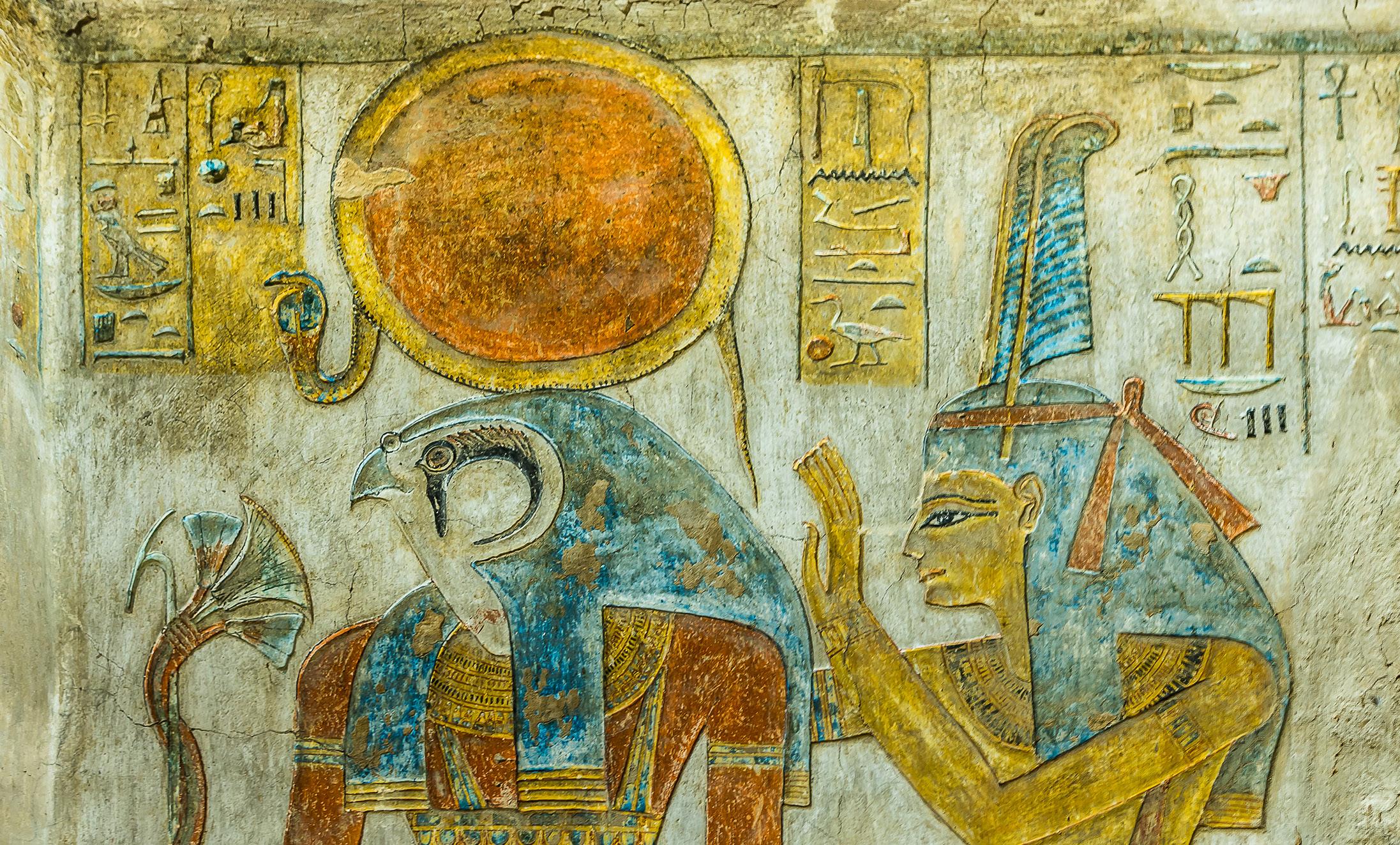
Many deities throughout ancient Egypt were shown with the heads or bodies of animals. For example, the goddess of war, Sekhmet, was shown as a lion, and the god of water, Sobek, was represented as a crocodile. As a result, many priests and priestesses kept crocodiles as pets and spoilt them with offerings of food.
The Egyptian goddess Bastet, the protector of homes, was shown as a cat. The ancient Egyptians valued cats highly, not only out of respect for Bastet, but also because they protected their grain stores by killing vermin such as mice and rats. Households treated cats very well; harming or killing a cat was often punished by death. The Greek historian Herodotus wrote that when a cat in ancient Egypt died, the occupants of the house would mourn and often shave their eyebrows to show their loss.
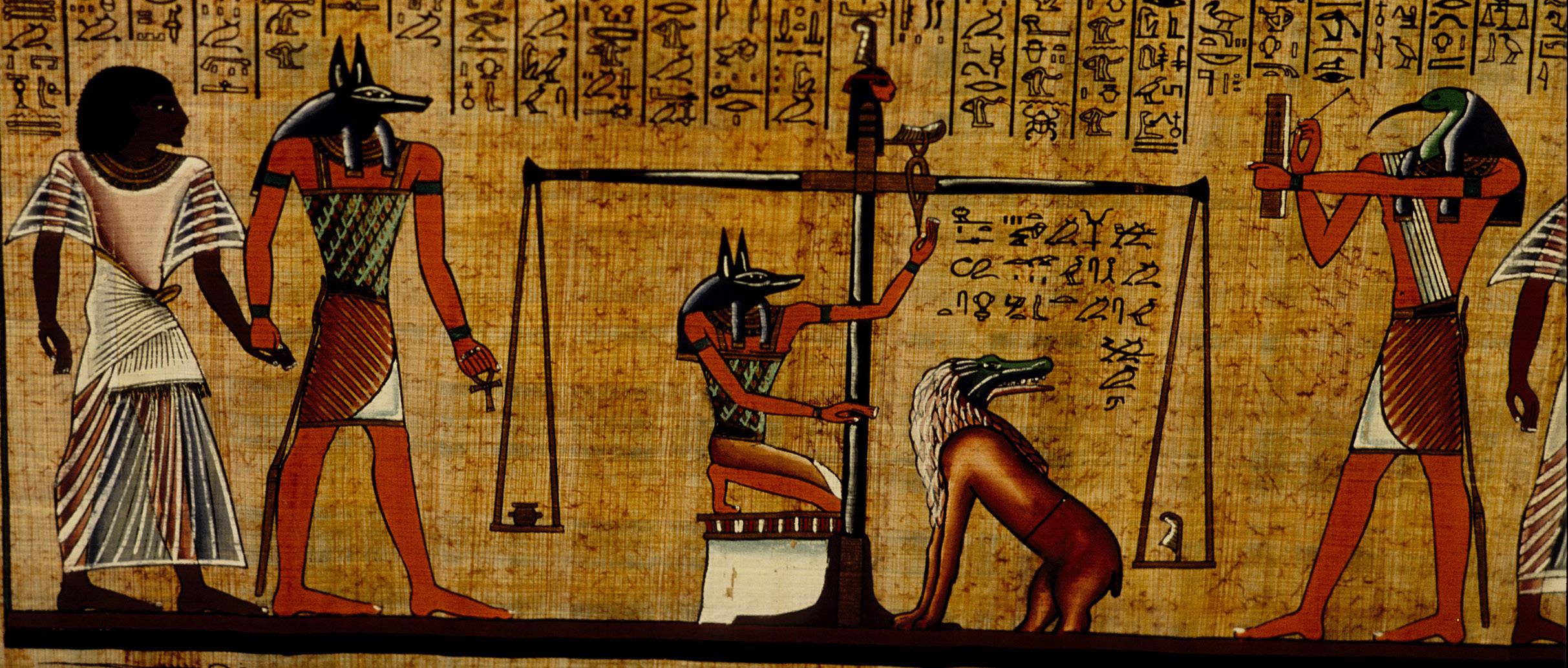
Check your learning 10.7
Check your learning 10.7
Review and understand
1 Who was the most significant Egyptian god? Outline why this god was so important.
2 How were gods worshipped in ancient Egypt?
3 Identify the ways that ordinary people tried to keep evil spirits away and how they tried to attract protection from the gods.
Apply and analyse
4 Explain why cats were valued highly in ancient Egypt.
5 Look closely at Source 2. Determine (decide) whether it is a primary or a secondary source, and give reasons for your answer.
Evaluate and create
a Using the internet, research three Egyptian deities other than Ra. Find out how they were depicted. Look particularly at their heads.
b Create three new gods: a god of peace, a god of greed and a god of courage. Draw sketches of them, remembering to pay attention to the head.

Learning intentions and success criteria
Ancient Egypt was a highly organised civilisation that was deeply influenced by its people’s beliefs, values and practices. This influence was evident in various aspects of the ancient Egyptians’ daily lives.
Key content video:
Everyday life in ancient Egypt
Quiz me!
Everyday life in ancient Egypt

Source 2 These musical instruments, known as sistra , made a loud clanging sound when shaken as the moving metal parts banged into each other.
hieroglyphs picture-like signs used in the original writing system of the ancient Egyptians
Egyptians married as teenagers. Marriage was usually a business matter, arranged by the parents when the partners were young. This is why a man might, for example, marry his sister – to keep the money in the family. It seems not much fuss was made about weddings – the woman simply left home to live with her new husband. Yet marriage was seen (by law and religious belief) as a serious commitment; some marriages would also have involved mutual love and respect apart from economic arrangement.
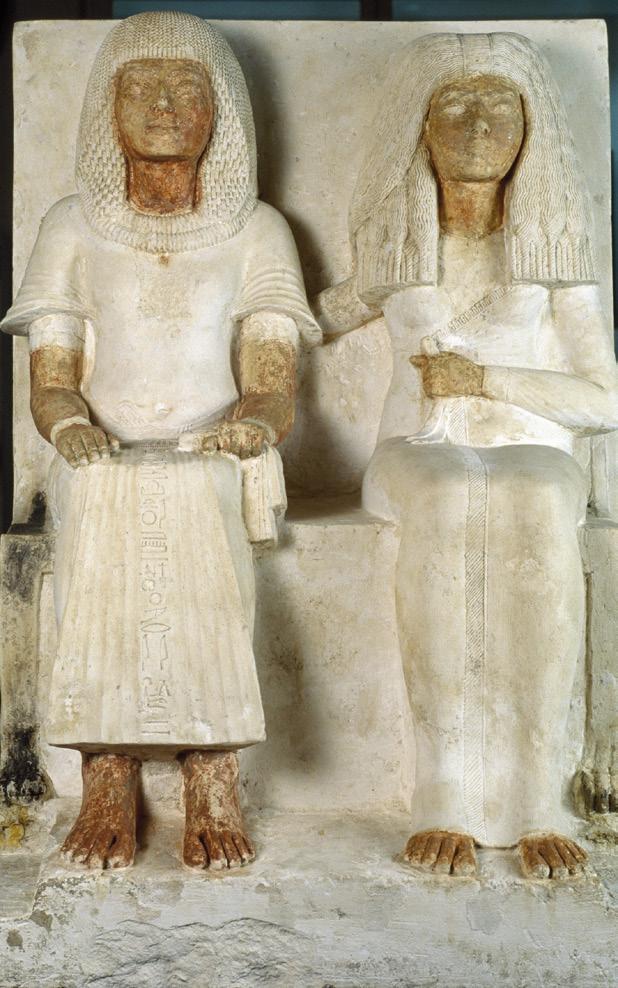
Childbirth was a risky business. There was a high loss of life for both babies and mothers. Some women gave birth in special "birthing houses" in temples. People often called on deities for help. For example, they might ask for support from Hathor, the goddess of women (represented as a cow). Or they would ask Ra, the main Egyptian deity, to send a wind to cool the mother.
The ancient Egyptians had a range of musical instruments, including harps, drums and sistra (see Source 2). Music and dance were always part of funerals. They were also seen as ways to communicate with deities such as Sekhmet. People who had done the wrong thing were very scared of this goddess, because they believed she would destroy the wicked. Dancing was a way to appeal to her mercy. The ancient Egyptians also believed that sistra both honoured the god Hathor and frightened off the desert god Set (the god of chaos).
Only around 1 per cent of people in ancient Egypt learnt to read and write. These people, almost always men, were highly respected. They were called scribes (see Lesson 10.4 Key groups in Egyptian society page 14).
During the period of the Old Kingdom, the ancient Egyptians used hieroglyphs, which were a form of writing or script. This script contained over 750 symbols. As
time passed, the ancient Egyptians developed simpler scripts –the demotic and hieratic scripts. These could be written more quickly, and were used for everyday writing.
The ancient Egyptians valued cleanliness. The wealthy bathed often. Priests used to shave their entire bodies regularly, and wash up to four times a day, so that they were completely clean when performing their religious duties. Slaves, on the other hand, washed rarely and so could be smelly and sticky. Records describe how one pharaoh, Pepy II, used to surround himself with naked slaves who were smeared with honey, so that flies would annoy them instead of him.

Source 3 Ancient Egyptian hieroglyphs in the Temple of the Dead of Rameses III, Luxor
Despite Egyptians’ love of cleanliness, ancient Egypt was not a healthy place to live. Malnutrition was common, especially among the poor, and there were other problems. These included:
• mosquitoes that bred in the Nile, spreading diseases such as malaria, which causes flu-like symptoms including fever
• rubbish and human waste that were often dumped in the Nile and other canals, leading to diseases such as dysentery, which causes severe diarrhoea
• breathing in sand blown in from the deserts, which often led to a lung disease called silicosis
• fragments of rock left in flour from the stones used to grind the grain, which caused tooth damage and decay.
The ancient Egyptians discovered a lot about the human body through their practice of mummification. For example, they knew how to use hot knives during surgery to seal blood vessels in order to stop uncontrolled bleeding. However, healing and medicine also relied heavily on magic and the influence of the gods. Priests were often involved in medical treatments, reciting spells and performing magic rituals.
demotic and hieratic both simplified systems of writing based on hieroglyphs; demotic was faster and easier to write
1 Identify the ways in which ancient Egyptians showed that they valued cleanliness and their physical appearance.
2 Why were scribes so highly valued?
3 Identify the practice that advanced the knowledge of anatomy for the ancient Egyptians.
4 Outline the role of music and dance in the society of ancient Egypt.
5 Apply and analyse
6 Explain why ancient Egyptians often suffered from each of the following: bacterial infections, bad teeth and silicosis.
7 Explain why women called on gods when giving birth in ancient Egypt.
Evaluate and create
8 Over time, written forms of communication developed and changed in ancient Egypt. Propose why these changes happened.
Learning intentions and success criteria
Ancient Egypt had a fairly peaceful early history, mainly because the physical features that surrounded ancient Egypt, such as mountains and deserts, acted as natural barriers against invasion. During the Old Kingdom, Egypt had only a small army. During the Middle and New Kingdoms, however, the army grew into a large, wellorganised group because the pharaoh’s rule was often threatened
Ancient Egypt’s army was similar to a loosely organised police force. It had three main roles:
1 to keep law and order
2 to protect the pharaoh and his palace
3 to guard borders.
One of the pharaoh’s main responsibilities was to protect the Egyptian people from attack. The pharaoh was considered to be a god, so he had to make his people believe that he was strong enough to protect them. This was one of the reasons why many pharaohs built huge statues of themselves.
The army included both foot soldiers (those who walked and fought on the ground) and charioteers (soldiers who drove and fought from horse-drawn chariots like the one shown in Source 1). Usually, there were two charioteers in each chariot. One man steered the horses and the other used the weapons (usually a bow and arrow, and a spear). It cost a lot of money to buy a chariot and horses, so only wealthy men could become charioteers. Successful charioteers were considered heroes.

Evidence from ancient Egyptian sources shows that army life was tough. Soldiers had to participate in a very challenging program of weapons training and physical exercise. Soldiers who did anything wrong might be whipped. Often, soldiers had to go on long marches through the desert.
Ancient Egyptians could be very harsh in their treatment of enemies they fought and conquered. There are accounts of corpses being destroyed, with body parts such as arms and heads chopped off to present to
the pharaoh or the gods. However, there were also many occasions of mercy. For example, conquered leaders were sometimes allowed to continue to rule their local region as long as they acknowledged the pharaoh as supreme ruler.
Soldiers did not wear much clothing, mainly because of the heat. They would usually wear a belt and loincloth, or a short tunic. They did not wear headgear. Some charioteers wore a type of armour on their upper body, made from leather straps. It seems that only the pharaohs wore metal armour, but not all the time. This armour was made from overlapping bronze pieces. Pharaohs would also wear a special headpiece during battle, known as the khepresh or blue crown. It was usually made of cloth or leather stained blue and covered with small gold or bronze discs.
Many weapons also served as farming tools. For example, axes might chop down palm trees as well as enemy bodies. Spears might kill creatures such as lions as well as men. Throwing sticks were useful for hunting birds. Many weapons, such as the mace, had religious importance. Archaeologists have often found weapons in graves alongside the remains of ancient Egyptian bodies.

Source 3 Some weapons used by soldiers in ancient Egypt
Weapons used in ancient Egypt
Flint and bronze knives
Swords and daggers (made of bronze, and later iron)
Bows and arrows
Spears
Maces (heavy clubs with stone or copper "heads")
Battleaxes
Shields
Battering rams and scaling ladders (for attacking buildings with high walls)
1 The army of ancient Egypt had two main types of soldiers. Identify them and describe how they fought.
2 Write a short paragraph to describe what life was like for a soldier.
3 Explain why the Old Kingdom of ancient Egypt only needed a small army. Evaluate and create
4 After some battles, ancient Egyptian soldiers cut off parts of people they had killed in battle and presented them to the pharaoh or as offerings to the gods. Propose (put forward) two reasons why you think they might have done this.
5 With a partner, create a role play between two soldiers who are discussing what life is like in the army – both in training and in battle.
Learning intentions and success criteria
Religion played a major part in the life and death of ancient Egyptians. For those who were considered worthy, death was not seen as the end. Instead, it was regarded as the start of a different sort of existence. To be worthy, each person had to live a good life. In addition to living a good and honest life, there were a number of rituals that needed to be performed to ensure a smooth journey into the afterlife. These included:
Key content video: Death and funeral customs in ancient Egypt
sarcophagus the outer case (usually stone) of the nest of coffins containing the dead body of a person of importance
• preserving the body after death through a process known as mummification
• reciting certain magic spells to ensure the person’s safe passage into the afterlife
• making sure that the dead person had access to what he or she would need in the afterlife. These items needed to be placed in the person’s tomb.
Once a person’s body was ready for burial, a procession including family, priests and professional mourners would take the body to its tomb. At the entrance of the tomb, the priests performed various rituals, including the "opening of the mouth" ceremony. A priest touched all the head openings of the mummified body with an axe-like tool. This was believed to awaken the dead person’s senses. The coffin was then sealed up and placed in the stone sarcophagus. The dead person was now ready to start the journey into the afterlife.
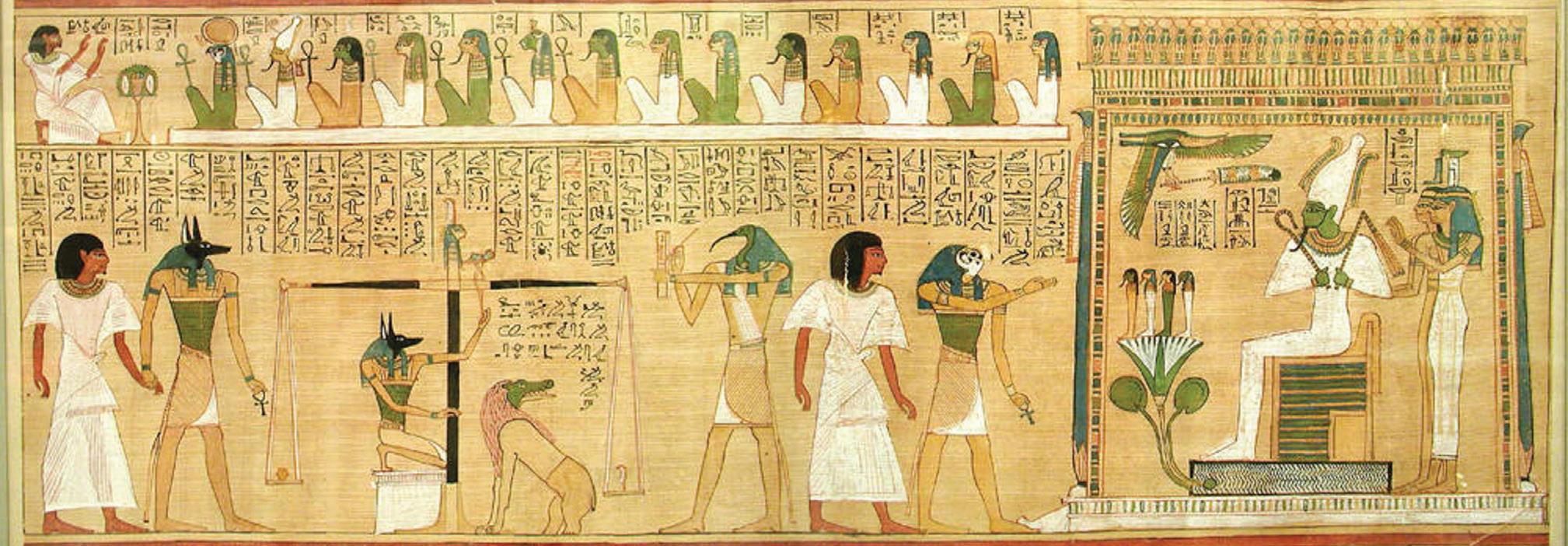
a Anubis, god of embalming and the dead, leads the dead person to judgment.
b A row of judges sit watching.
c Anubis weighs the dead person’s heart against a feather from the headdress of Ma’at, the goddess of truth and justice. If the heart is lighter than the feather, it means the person has led a good life and will be admitted to the afterlife.
d Ammit, a female demon with the head of a crocodile, will eat the dead person’s heart if it is heavier than the feather.
e Thoth, god of writing and knowledge, records the result of the weigh-in.
f Horus, god of the sky and ruler of the world of the living, leads the dead person (who has passed the test) to Osiris.
g Osiris, god of the dead and the underworld, allows the person into the afterlife.
In order to reach the afterlife, the ancient Egyptians believed that the dead person would need magic spells and special prayers to support them through any dangers and further rituals on their journey. These spells and prayers were recorded in a special text known as the Book of the Dead . A copy of the Book of the Dead was often buried with the dead person.
One of the important rituals the dead person must undergo before being allowed into the afterlife was the "weighing of the heart". In ancient Egypt, it was believed that the heart contained the soul, so the weighing of the heart was a kind of final judgment. The ritual is explained in Source 1
The earliest tombs were often graves in the desert. The hot, dry sand soon sucked all moisture from the corpse, preserving it. The poor continued to be buried this way even after burial practices had changed.
The first above-ground tombs were called mastabas. These were large, box-like structures. Many mastabas had detailed designs, with stones in patterns decorating the walls. Perhaps the best-known above-ground tombs were the pyramids. Today, more than 160 pyramids have been found.
When grave robbers started becoming a problem, tombs for important people such as pharaohs were dug underground in places such as the Valley of the Kings. This began to happen from about 1500 BCE.
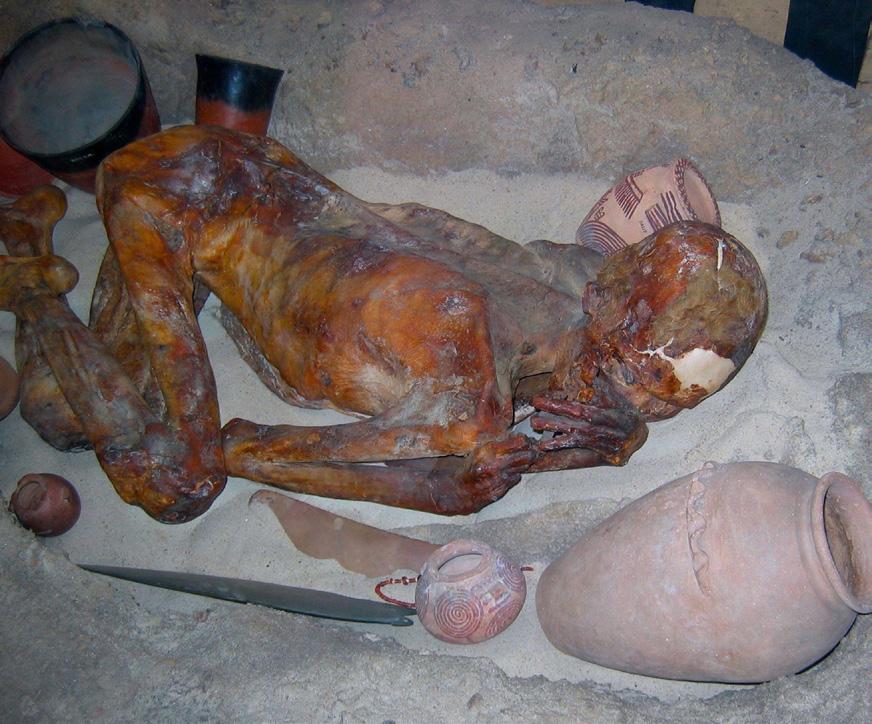
Egyptians buried their dead with goods they believed would be needed in the afterlife – clothing, jewellery, pots, furniture, wigs, tools, chariots, boats, food and even servants! Later, small models of servants were used instead of the real servants.
Review and understand
1 In your own words, define the following terms: a mastabas b pyramids.
2 Outline what the Book of the Dead was, including the role it played in Egyptian funeral customs.
3 Why was it so important to ancient Egyptians to preserve the body when someone died?
4 What role did climate and physical features have in ancient Egyptian burial practices?
5 Analyse the connection between burial rituals and grave robbing in ancient Egypt.
6 Look at Source 1. Explain why "having a heavy heart" might indicate that a person has not led a good life.
Evaluate and create
7 Discuss how religion influenced the burial and funerary customs of the ancient Egyptians. Look closely at the sources in this topic to help you.
To the ancient Egyptians, reaching the afterlife was a complicated business. It was not enough for a person simply to be worthy, they also had to be prepared for the journey according to a number of rituals and be supplied with the necessary provisions and protections. Their bodies were preserved through the process of mummification (or embalming), which involved removing vital organs and placing charms and spells in specific areas (see Source 1).
Learning intentions and success criteria
scarab a type of beetle considered sacred by the ancient Egyptians; the word "scarab" also refers to items of stone or metal jewellery in the form of the scarab beetle
resin a sticky substance (similar to the sap from a tree) used in ancient Egypt to glue bandages together
Source 1 The steps followed during the mummification process.
a The dead body is brought for mummification followed by mourners.
b The body is thoroughly washed. A priest reads prayers from the Book of the Dead
c The liver, lungs, stomach and intestines are removed through a cut on the left side of the abdomen. A hook, pushed up through the nostrils, removes the brain (thought to be a useless organ that produces only mucus). The heart is left in the body.
e The body is then covered with salt for 70 days. This, and the dry air, sucks out any moisture. The body is washed again in water and smeared with fragrant oil.
f Once the body has been embalmed, it is wrapped with rolls of fine linen (similar to bandages), starting with the head and neck. Toes and fingers are wrapped separately, and sometimes covered with gold caps. Sacred amulets such as the scarab are wound into the bandaging. During the wrapping, prayers from the Book of the Dead are said over the body.
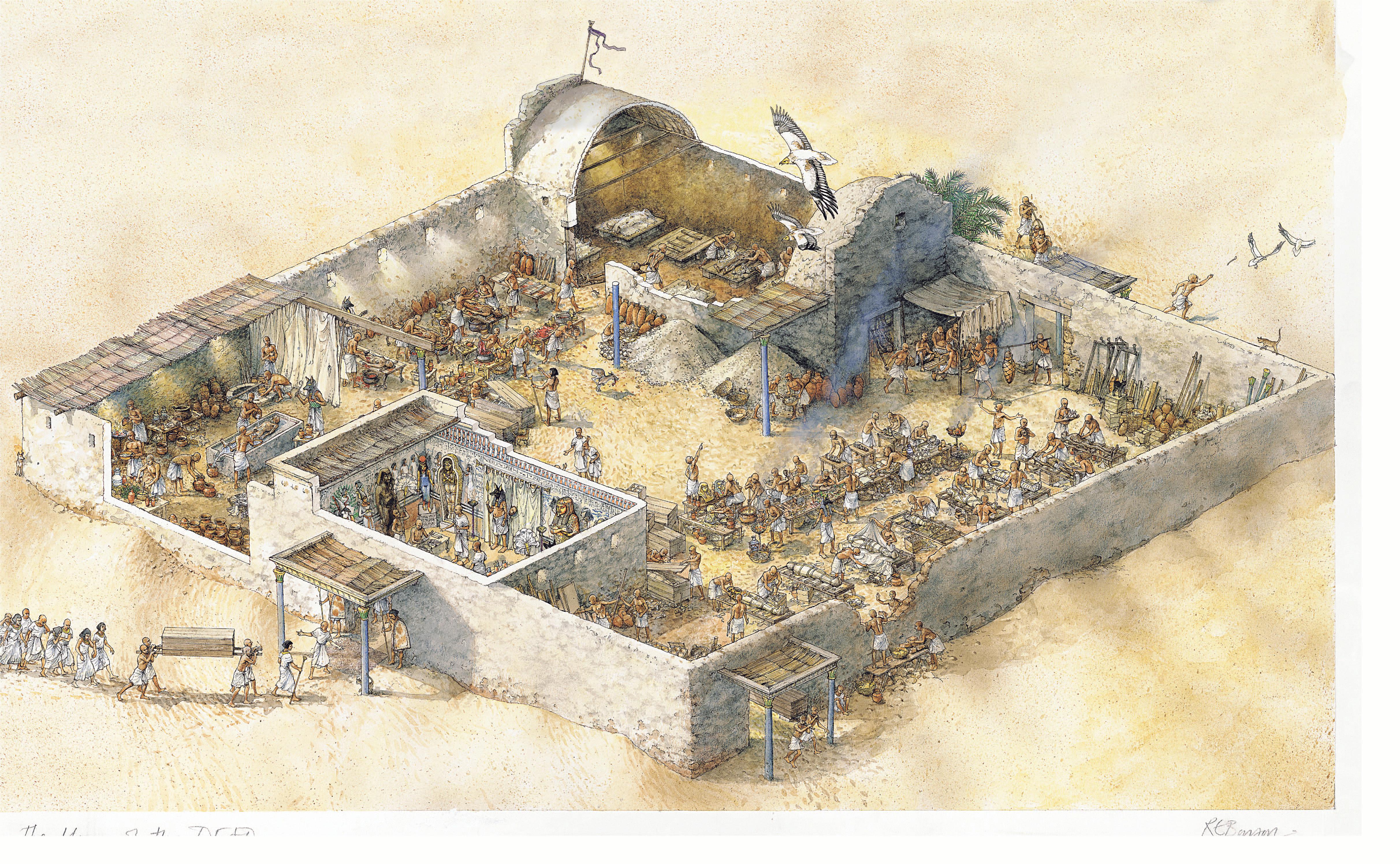
d The internal organs are dried in natron (a natural powder, a bit like salt), rubbed with fragrant oils and put into four canopic jars. Each jar lid is shaped like the head of a different god, who acts as the guardian of the organ inside: the liver has a lid like a man’s head; the lungs, a baboon’s head; the stomach, a jackal’s head; and the intestines, a falcon’s head.
g The fully bandaged mummy is painted with sticky resin, and then more cloth is wrapped around it.
h The mummy is put into a body-shaped coffin. Often more than one coffin is used, each one sitting inside the next. For important people like pharaohs, the nest of coffins is placed inside a stone box, called a sarcophagus
Key content video: How mummies were made
Interactive: The mummification process
Sequence this! Making mummies

I used to think, now I think Reflect on your learning about the mummification process and complete the following sentences.
• I used to think … Now I think … What has changed in your understanding?
1 Identify why the brain was thought to be a useless organ.
2 Describe what was done with a dead person’s internal organs during the mummification process.
3 Why were bodies covered with salt for 70 days?
4 Outline the religious ritual that was conducted as the bodies were wrapped in cloth.
5 Examine the various elements illustrated in Source 1. What evidence does this source provide about ancient Egyptian beliefs and values?
Interactive: The pyramids
The Great Pyramid at Giza is the only remaining wonder of the ancient world. It was built in c. 2580 BCE as the tomb of the Pharaoh Khufu. The question of how the Great Pyramid was constructed with such accuracy has mystified many historians.
Historians have come up with many different hypotheses about how it was built. Source 2 highlights the main steps that may have been used in the pyramid’s construction. It is important to note that there is some debate about how the Great Pyramid was constructed. There are no surviving texts or manuals to tell us exactly how it was built.
Source 2 Historians believe the building of the Great Pyramid at Giza took about 20 years and used more than 100,000 workers.
a The first step in the building of the pyramid was probably the selection of a workforce. It is believed that, during the inundation of the Nile, most of the workforce was made up of farmers who could not work on their farms because of the floodwaters.
b Posts were buried deep in the slopes so blocks could be hauled from below.
c Once the first later of blocks was laid, further blocks would then need to be dragged up to be placed on the next layer of the structure. There are many theories about how the blocks were moved, but a discovery of a modified ramp in an ancient quarry suggests this technology could have been used at the time the Great Pyramid was built. The three-metre-wide ramp had steps either side of it. Set alongside the steps on each side were built-in holes which would have been filled with thick wooden posts. Teams of builders would then have wrapped ropes around the posts to create pulleys that allowed blocks to be pulled upwards from below and above. The slope of the ramp grew as the size of the pyramid did.
d Scholars think that the blocks were probably dragged across wet sand on sleds to the base of the pyramid or, once construction started, to the bottom of the ramp. The sand in front of the sled was likely dampened with water to reduce friction, making it easier to move the sled.
e Most of the 2.3 million blocks used to build the Great Pyramid were limestone blocks, mined in local quarries. Others were heavy granite, found about 800 kilometres south of Aswan. They then had to be transported downriver on barges or ships.
f The base of the Great Pyramid is almost flat. This has left historians to believe that the area in which the Great Pyramid was to be build was first marked out and levelled. Marking out the ground involved complex mathematics. Precise calculations were required to set out where the corner blocks would be placed, the angle of the sloping sides, the height and the dead centre of the structure.
g Once completed, each later of the pyramid was coated with panels of white limestone.
h The final step in the construction of the pyramid of Giza was to place a pyramidion (a smaller pyramid cut from one piece of stone) on the very top. It was about 8 metres high and coated with a mix of gold and silver

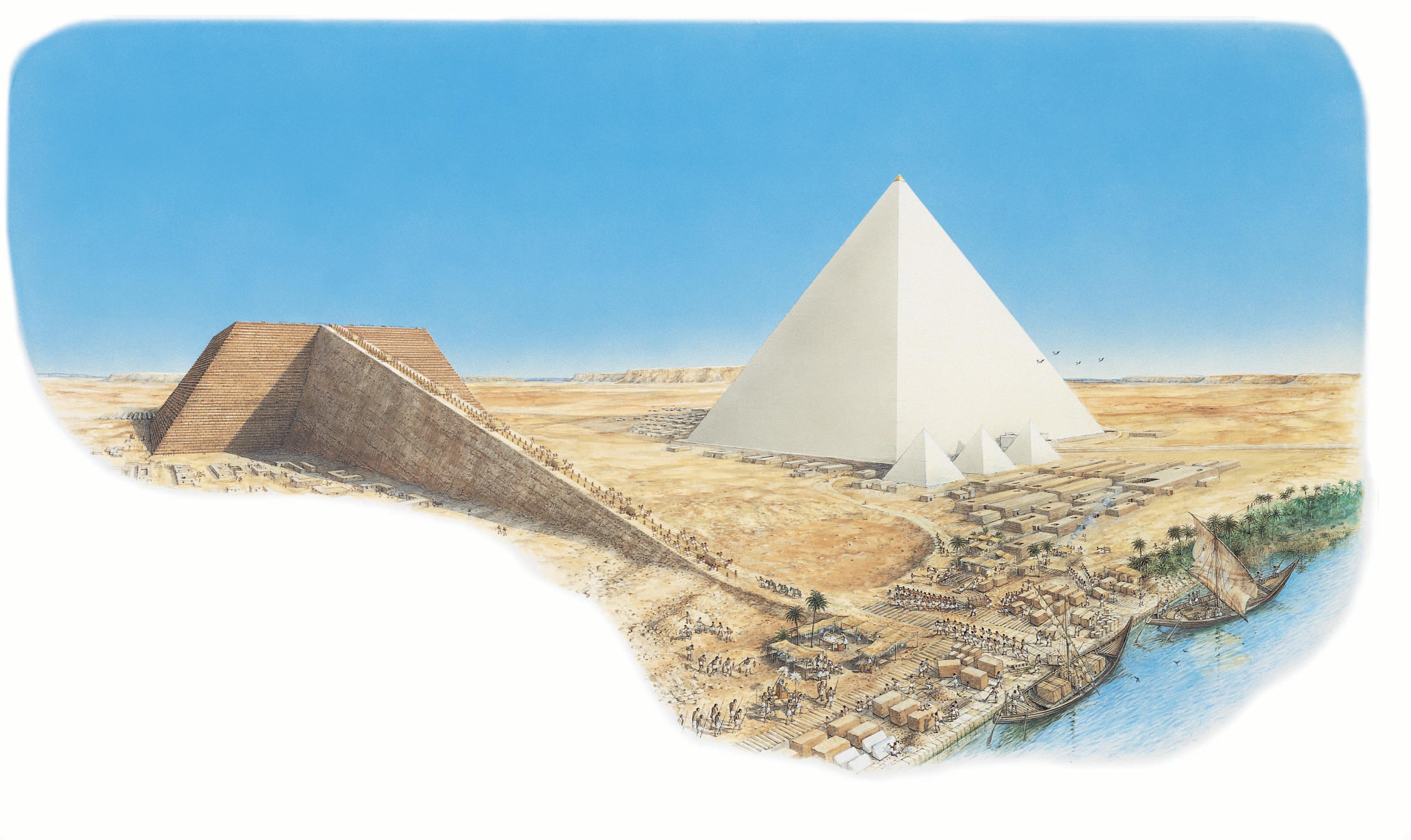





After conducting their research, historians need to be able to express and communicate their findings in a range of ways and using different forms. Sometimes, historians communicate their findings orally or in writing. At other times, historians use particular graphic organisers, such as flow charts, to communicate information.
Flow charts are a very useful tool for communicating steps in a process. To create a flow chart, you need to think carefully about the steps involved in a process, as well as the order in which these steps would have been performed. A good flow chart should include:
• written descriptions of each step
• a small drawing or visual representation of each step
• arrows between each step to show the order in which they were performed.
For more information on communicating, see Lesson 6.8 Communicating [crossreference:Lesson 6.8 Communicating]
1 Look carefully at Source 2. Identify what the key steps would have been in the building of the Great Pyramid, and the order they would have been carried out. Create a flow chart that outlines these steps, using the guidelines above.
1 Source 2 shows one theory of how the Great Pyramid was built, but some historians still contest this theory.
a Research theories about how the pyramids were built. For example:
» a ramp that winds around the pyramid
» ramping systems inside the pyramids
» some of the blocks being made on the pyramid.
b Describe each theory and draw a simple picture to illustrate how it may have worked.
c Which theory do you think is most likely to be correct? Justify (give reasons for) your answer.

Examine both sources carefully and answer the questions below.
Source 1 Wall painting from the tomb of Djehutihotep, who was a government official during the 12th Dynasty, c.1900 BCE.

Source 2
The famous scene from Djehutihotep's tomb illustrates well the reasons why the ancient Egyptians were so successful in manoeuvring and building such impressive monuments, which were accomplished by the combination of knowledge, skill and necessary man-power, the latter provided by a willing workforce drafted in especially for the task rather than an army of slaves so often portrayed in books and films …
The colossus has been placed on a wooden sledge for transportation … The hauliers are gliding the sledge over a layer of carefully prepared sand, and there is some speculation about the significance of the man pouring water in front of the sledge: he was originally thought to be offering a libation (a drink poured out as an offering to a deity) as part of a ceremony, but it has been recently proposed that the ancient Egyptians understood that if a certain amount of water is added to sand, it significantly reduces the amount of friction generated by the dragging of such heavy loads.
An analysis of Source 1, provided by The Griffith Institute.
1 Identify the role of Djehutihotep in ancient Egyptian society. (1 mark)
2 Determine (decide) whether the sources provided are primary or secondary sources. Give reasons for your answer. (3 marks)
a Explain the significance of the man pouring water in front of the sledge.
b What was it previously thought that the man was doing? (4 marks)
3 As you have learned, every source is created from a different perspective. Read Source 2 and list some of the words that the author has used that indicate their perspective on the ancient Egyptians’ construction skills. (2 marks)
4 Evaluate the construction abilities of the ancient Egyptians, using both sources to help you. (10 marks)
(Total: 20 marks)
Module checklist: Ancient Egypt
Module review quiz: Ancient Egypt